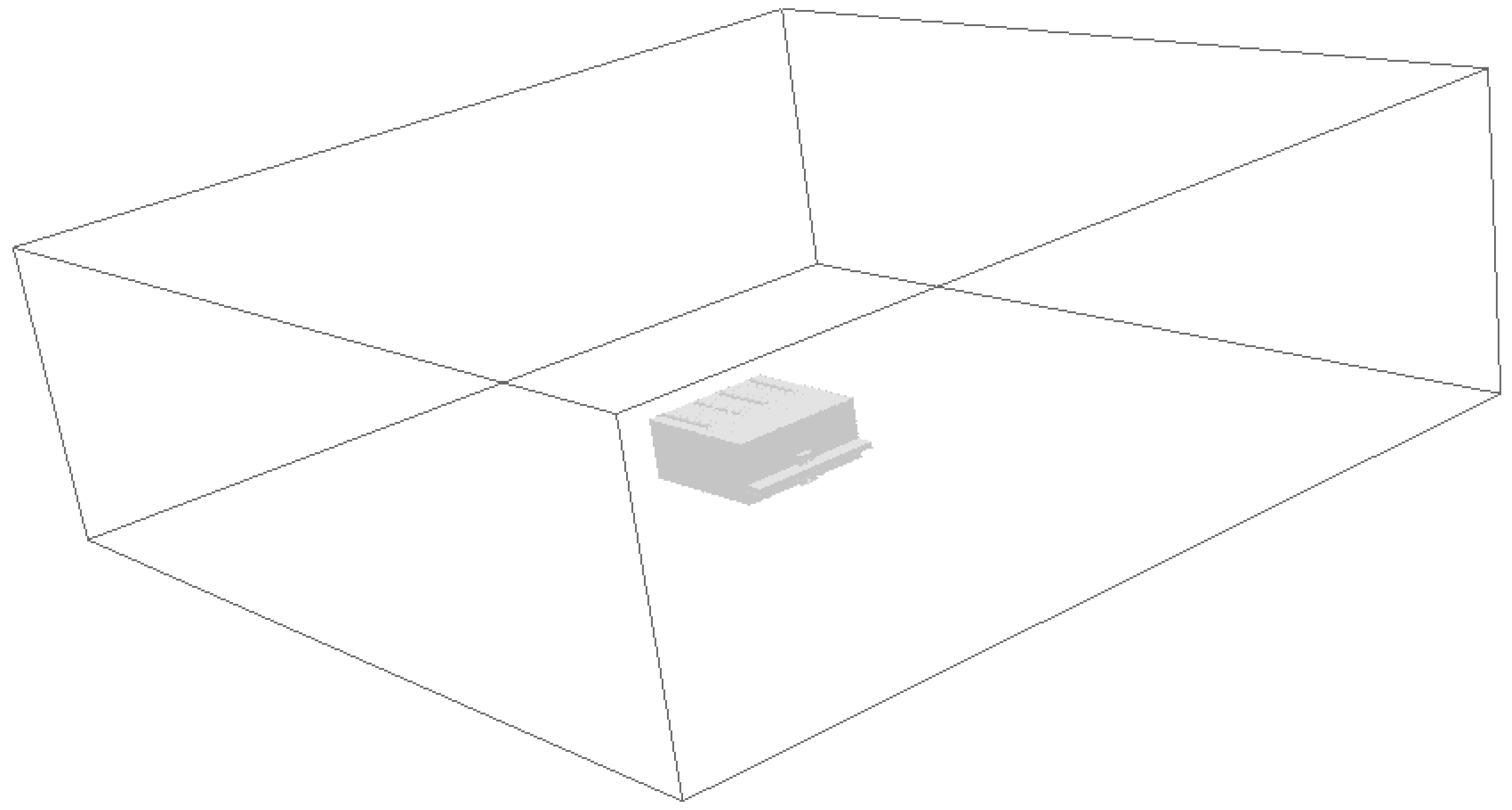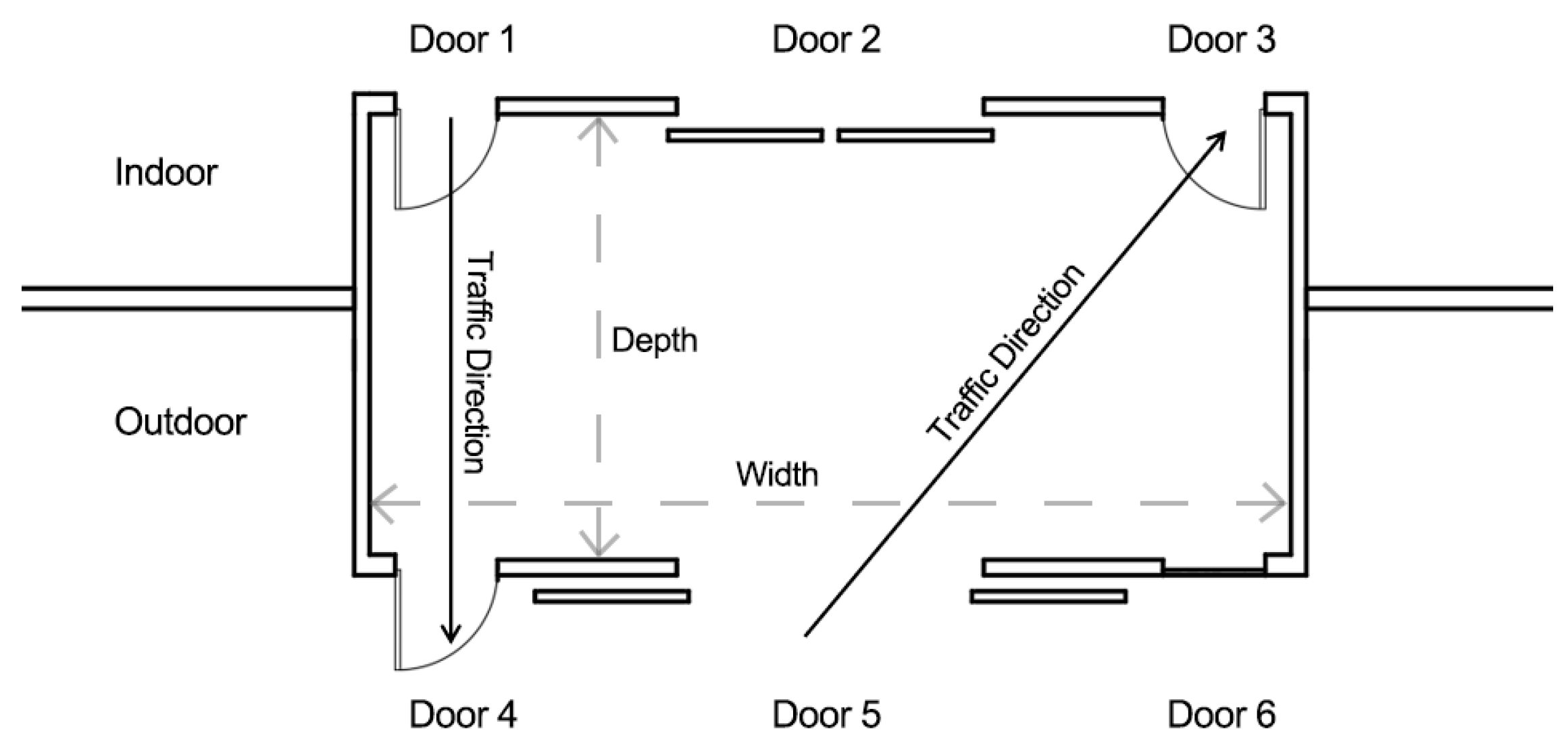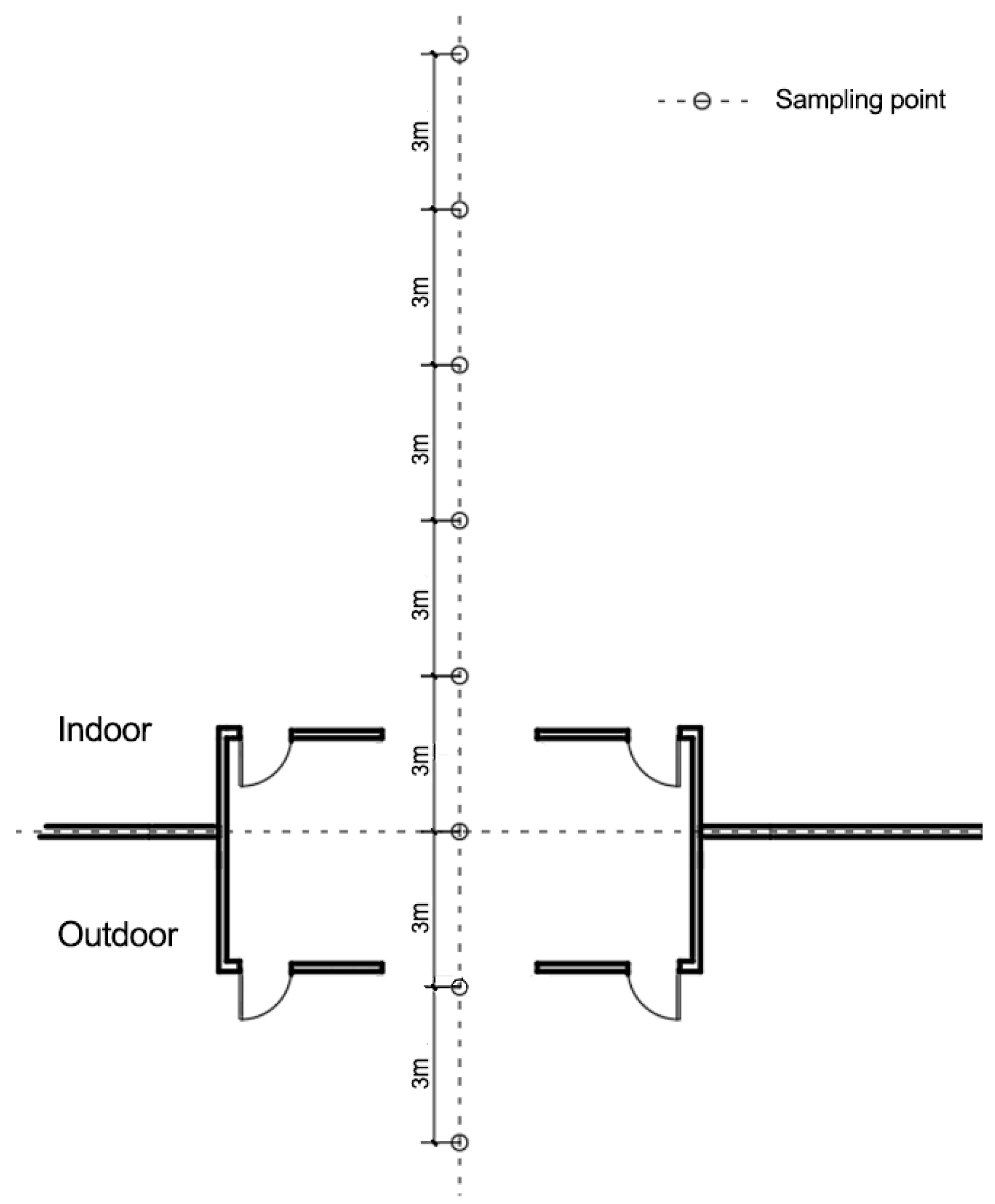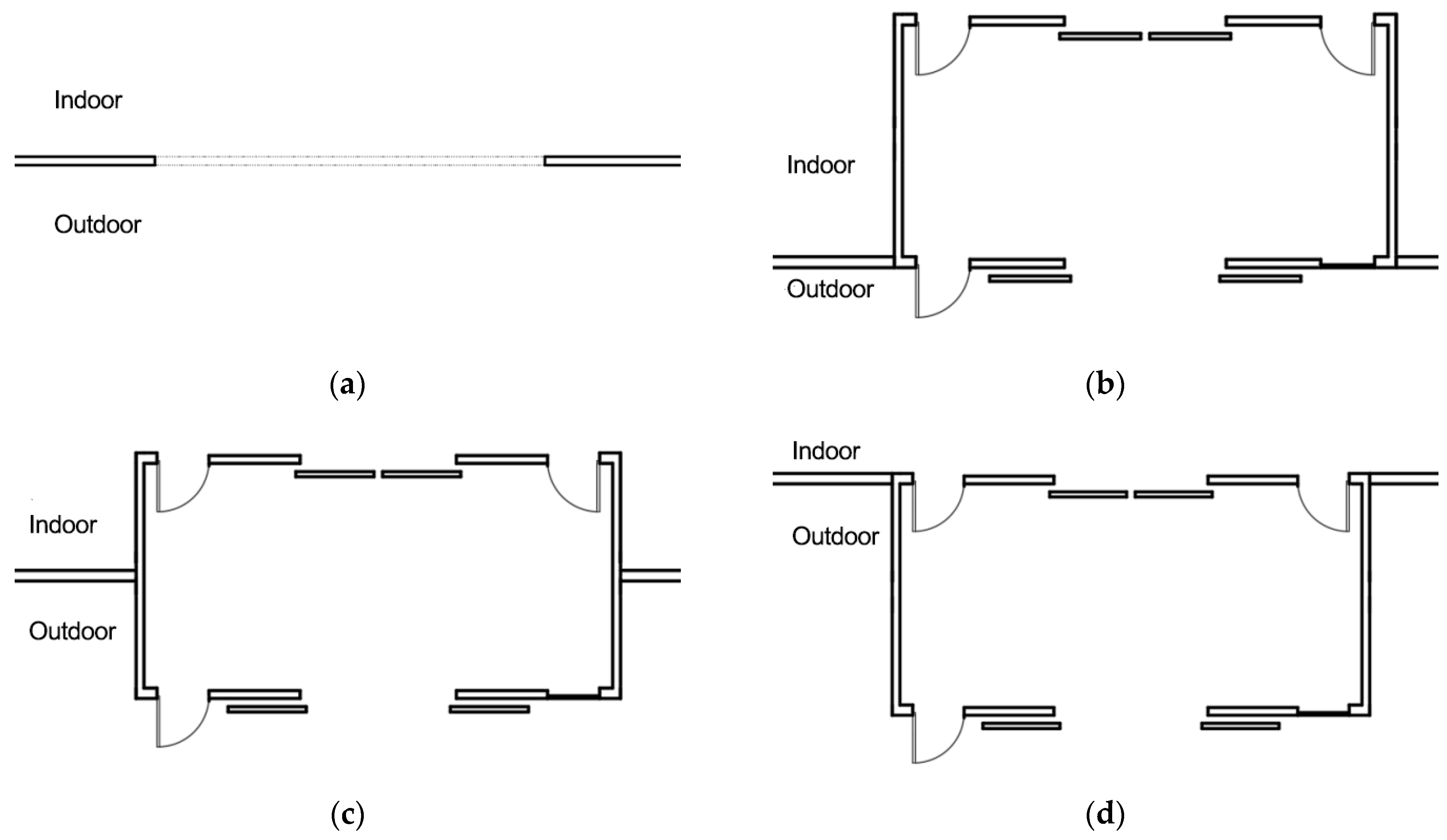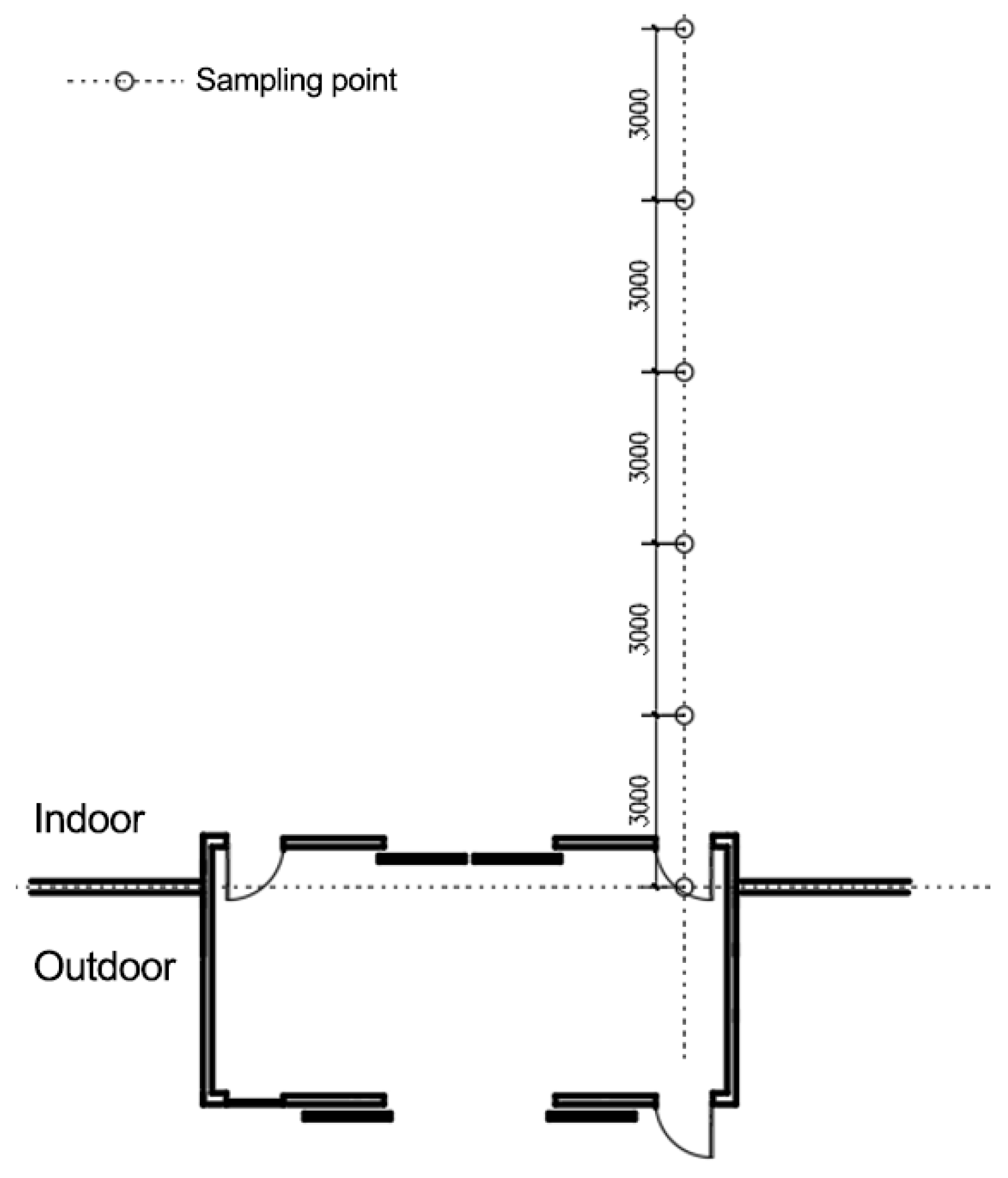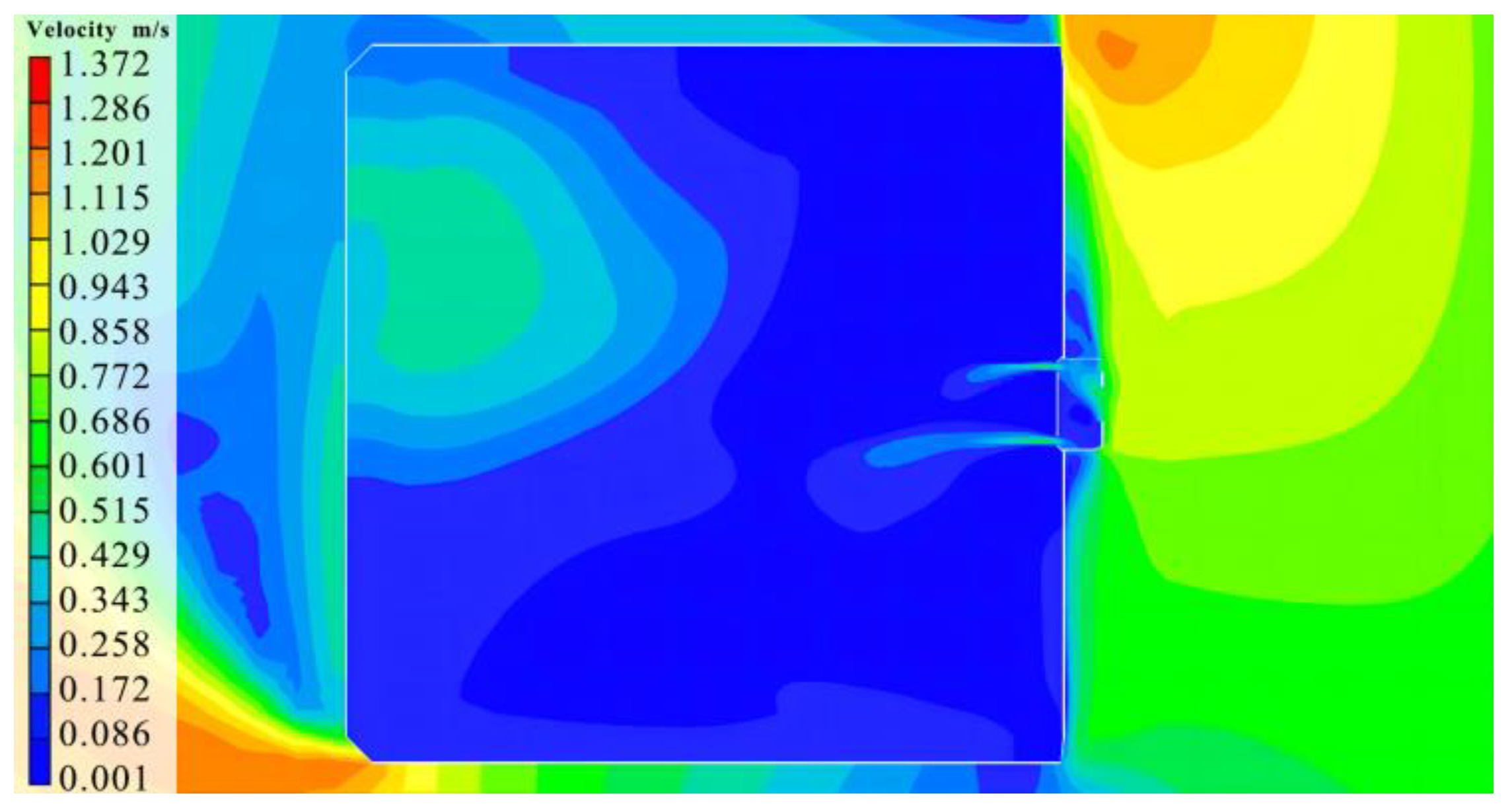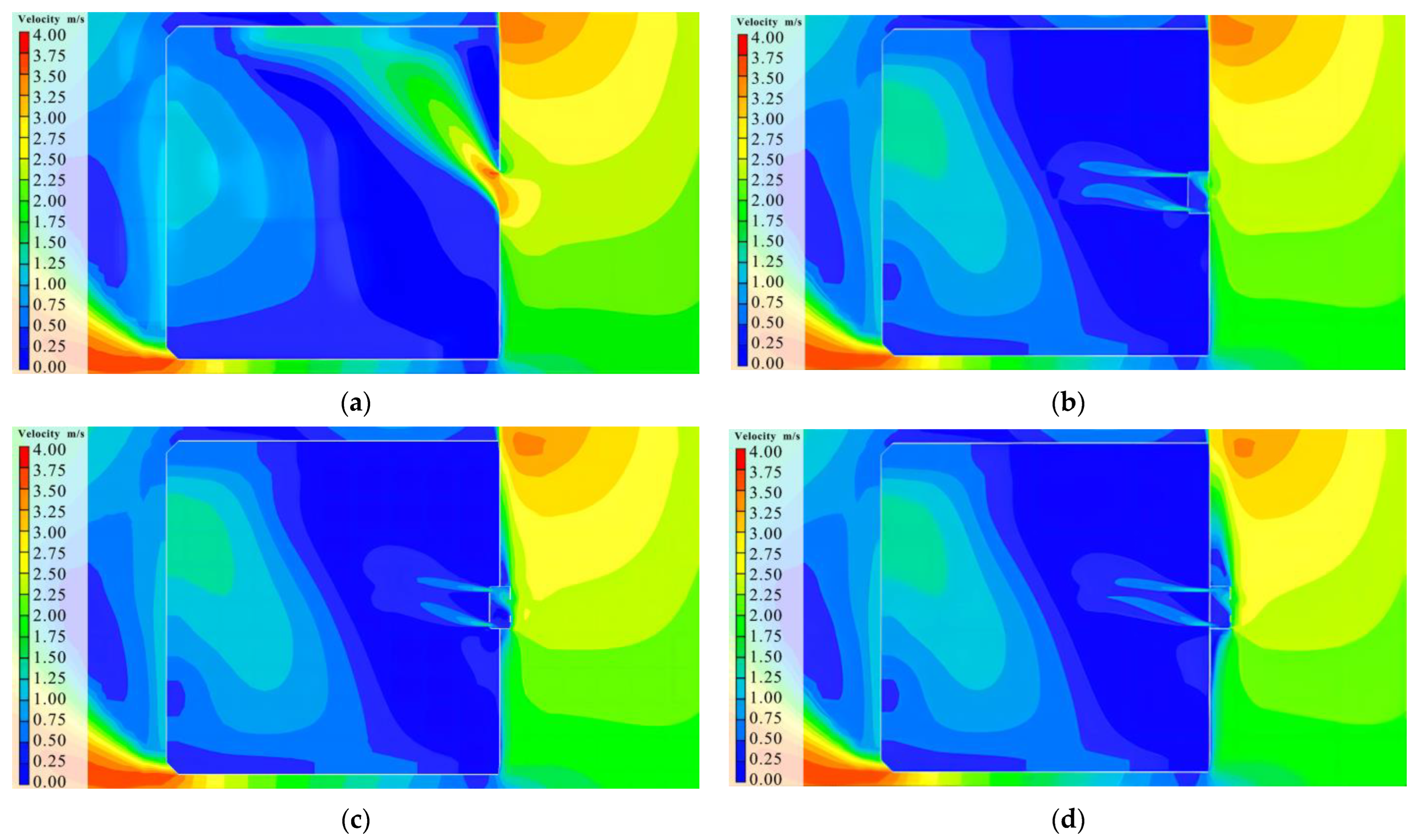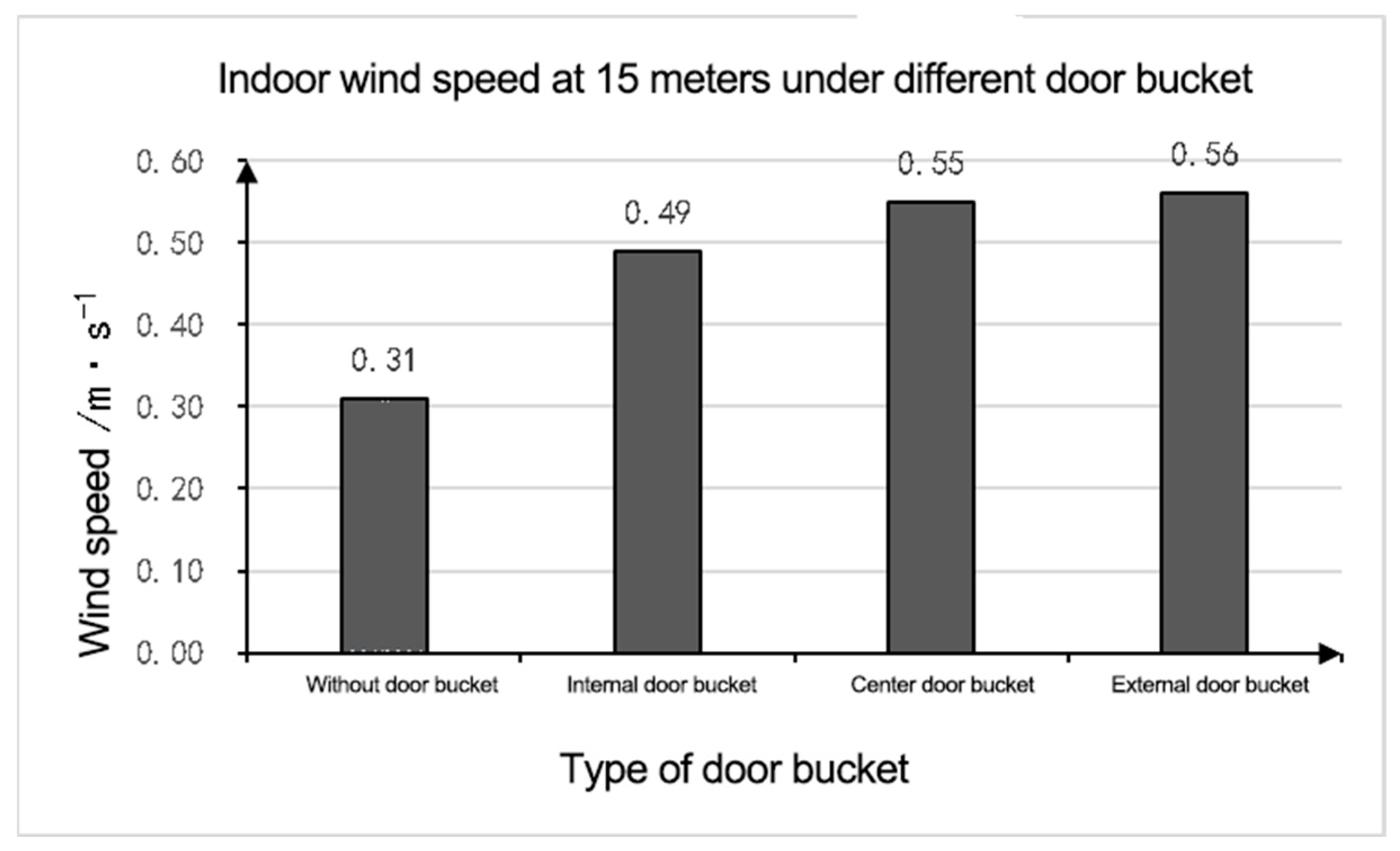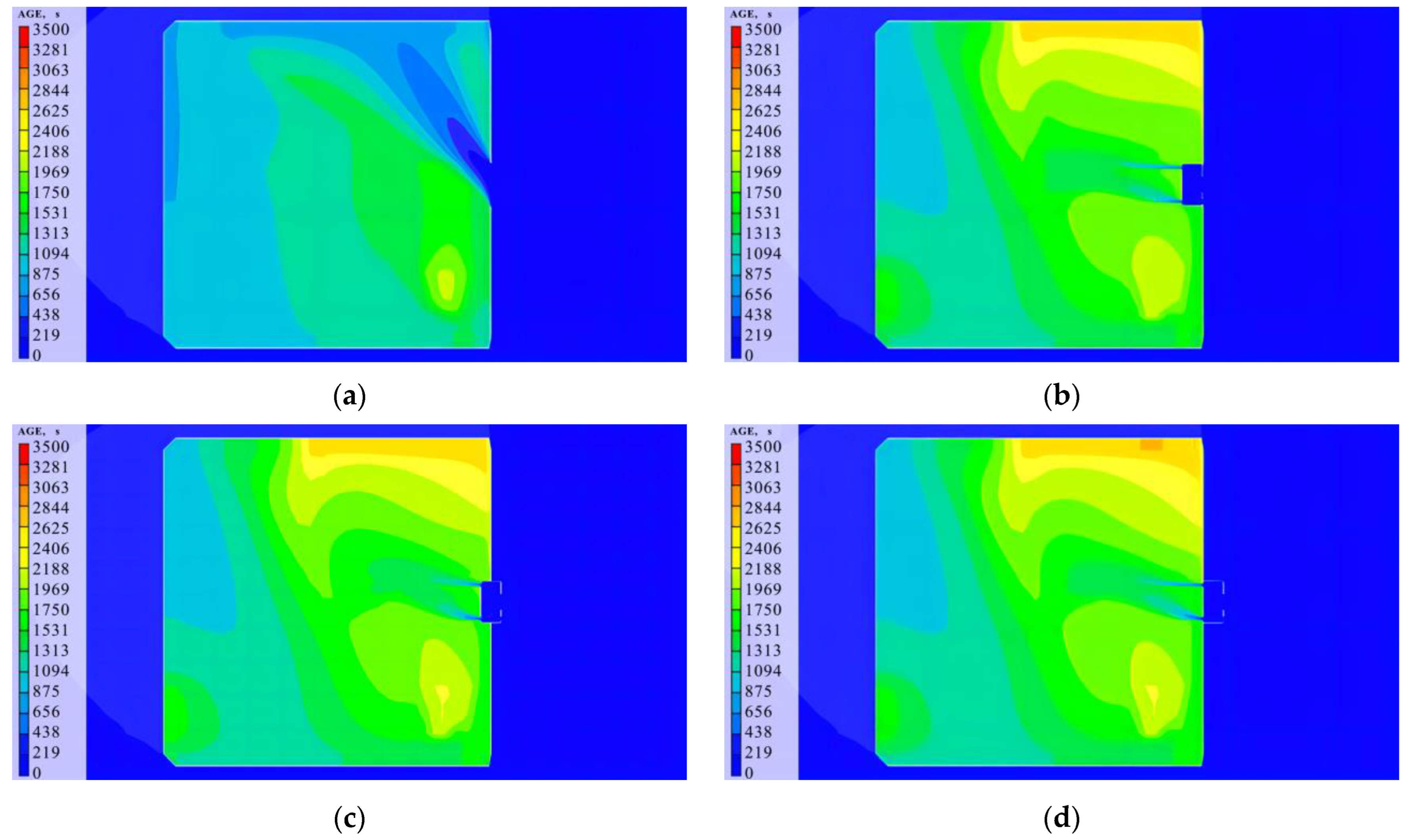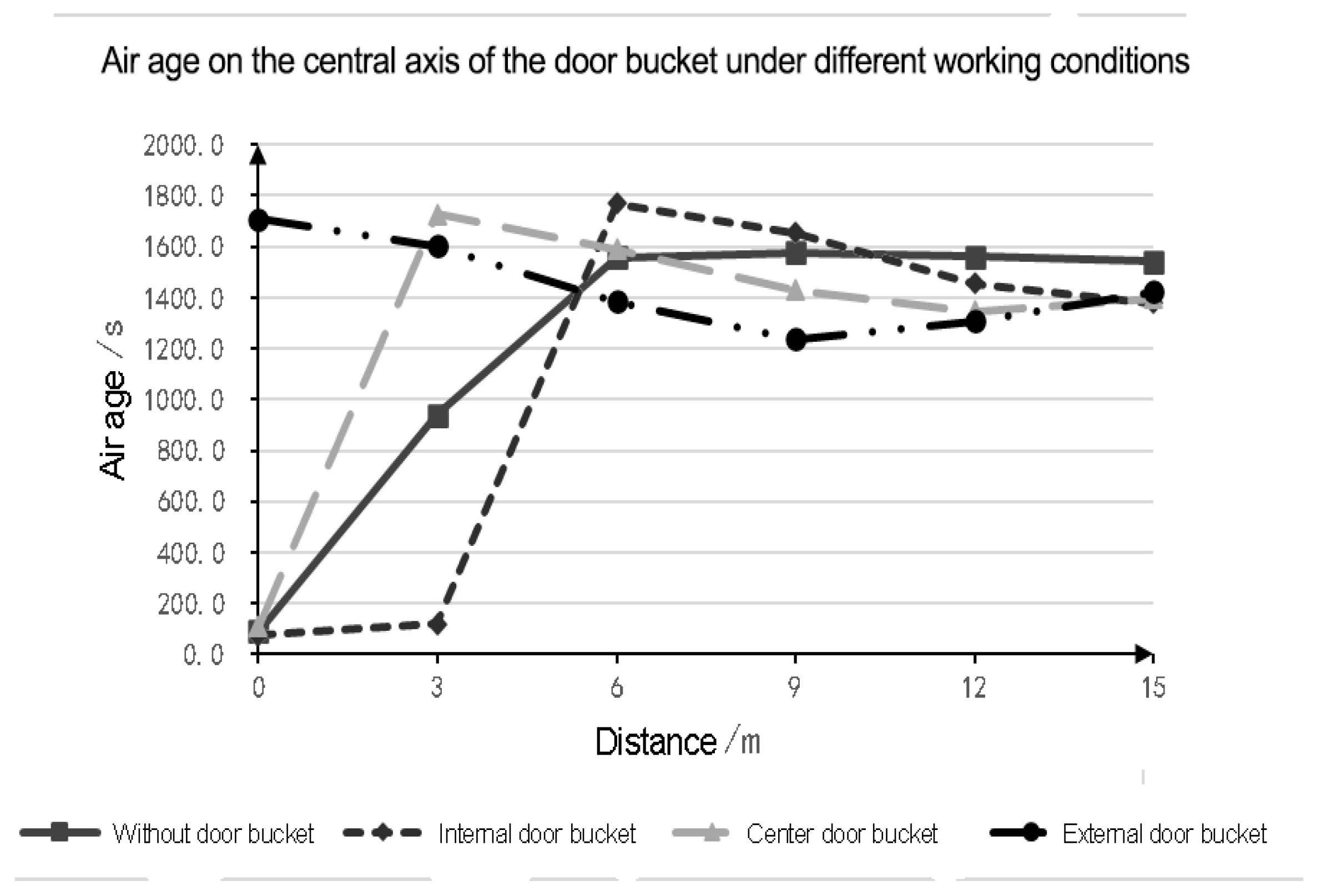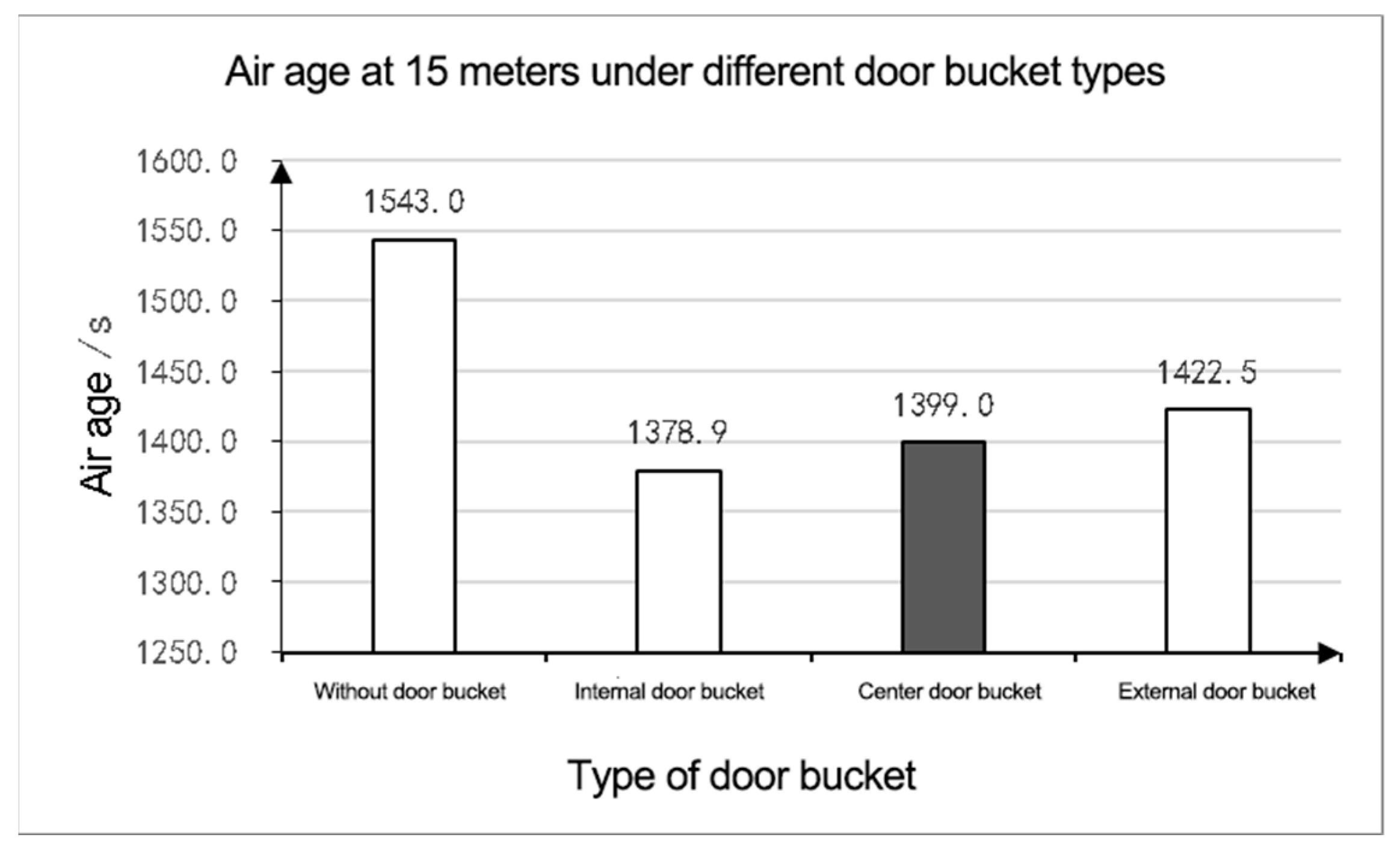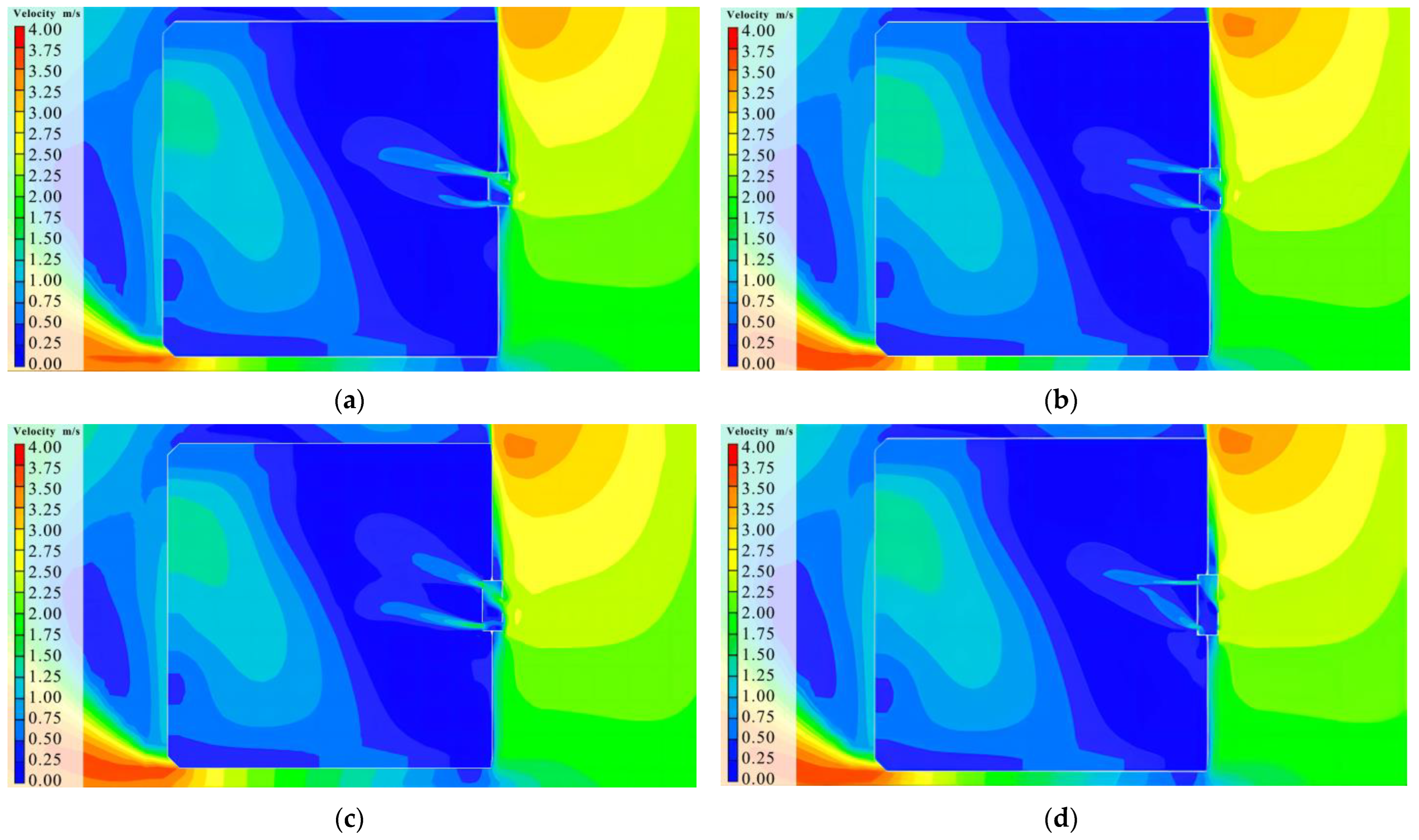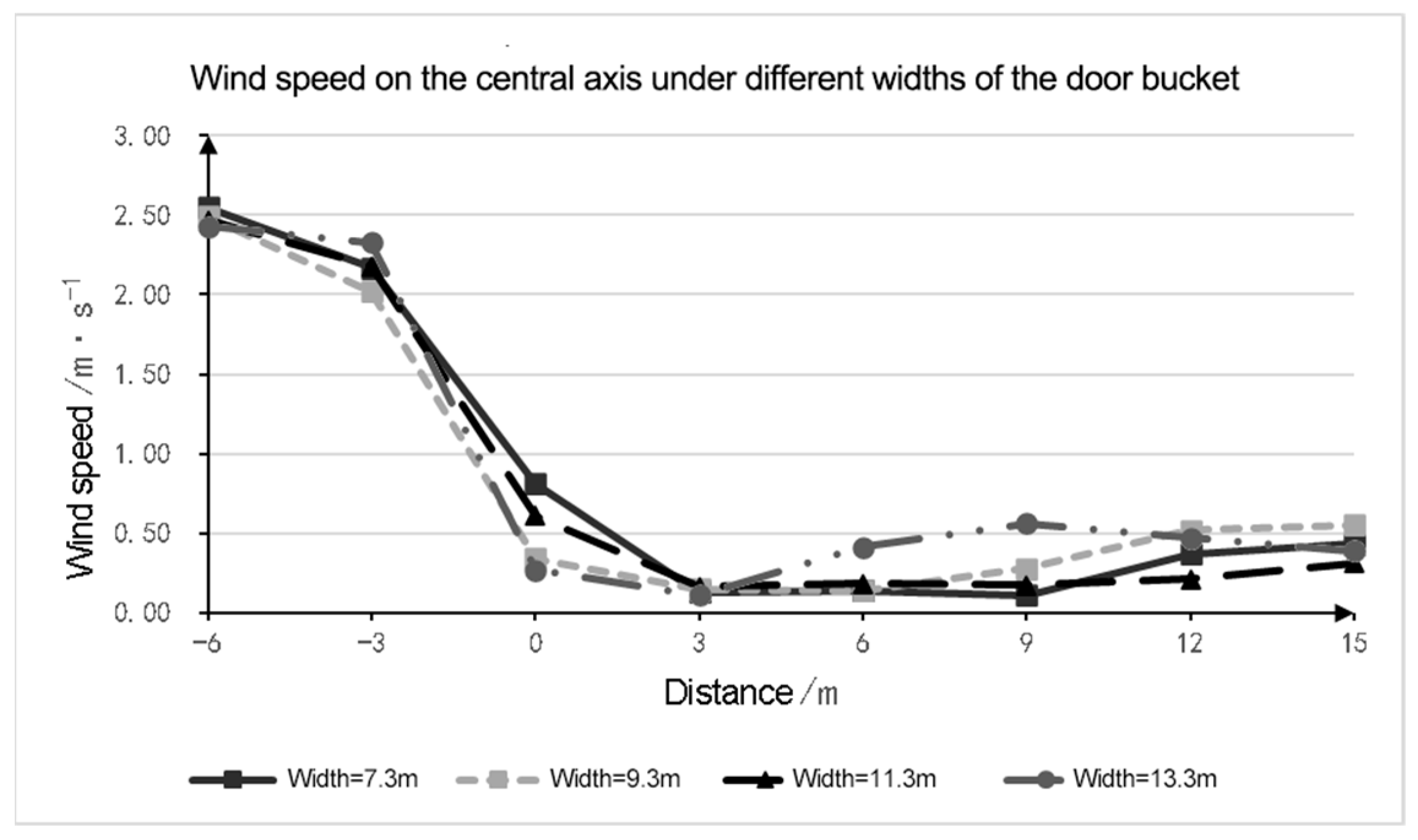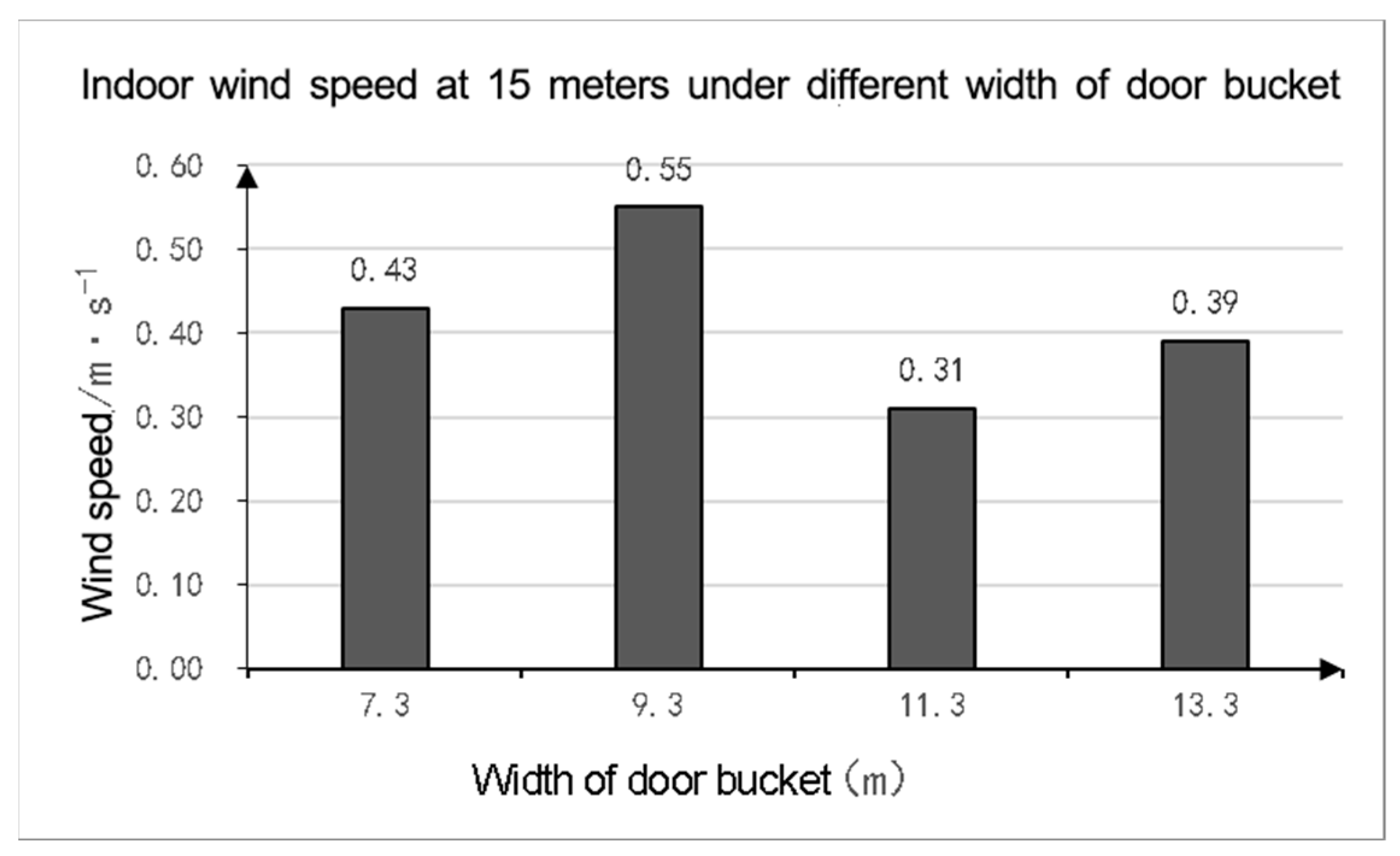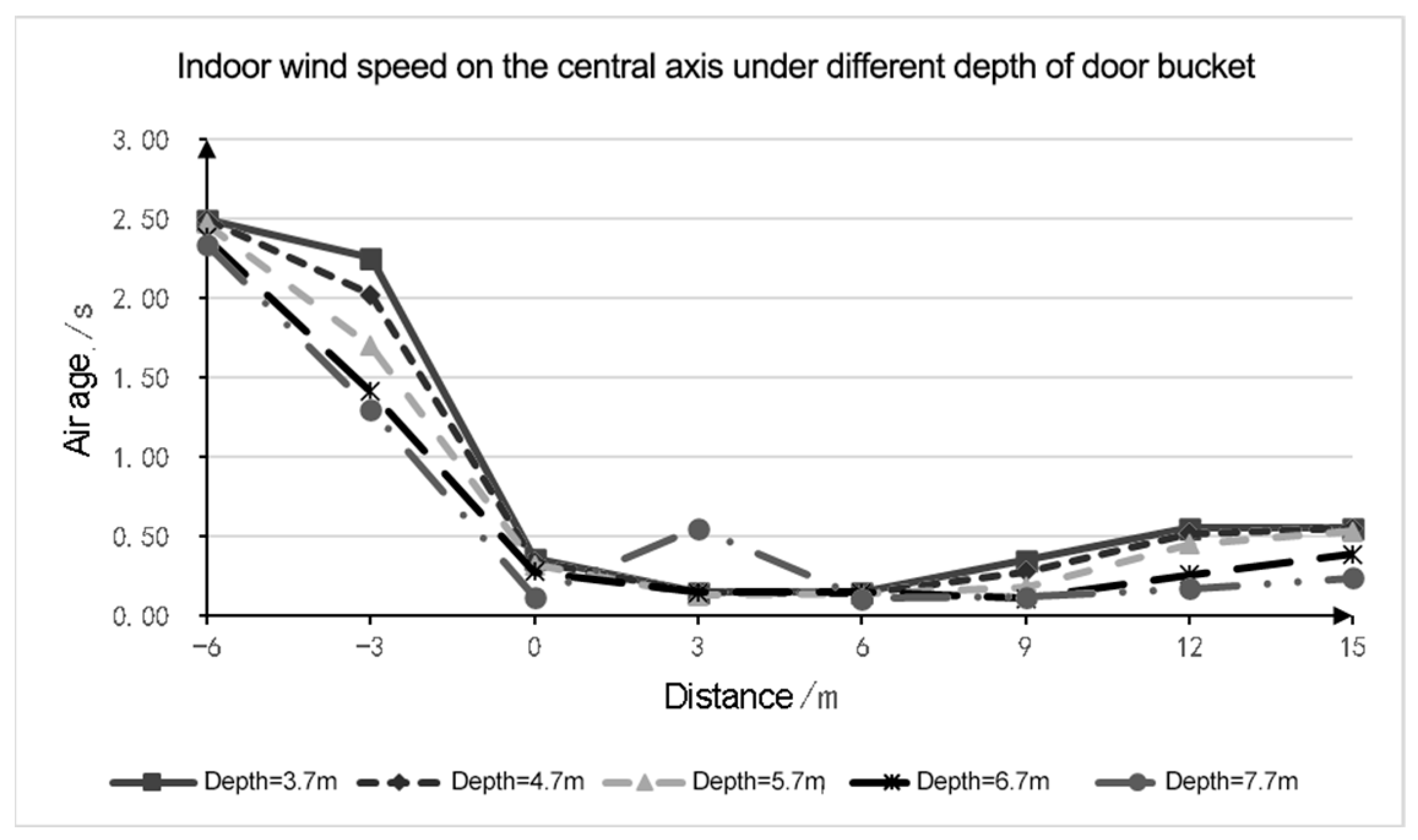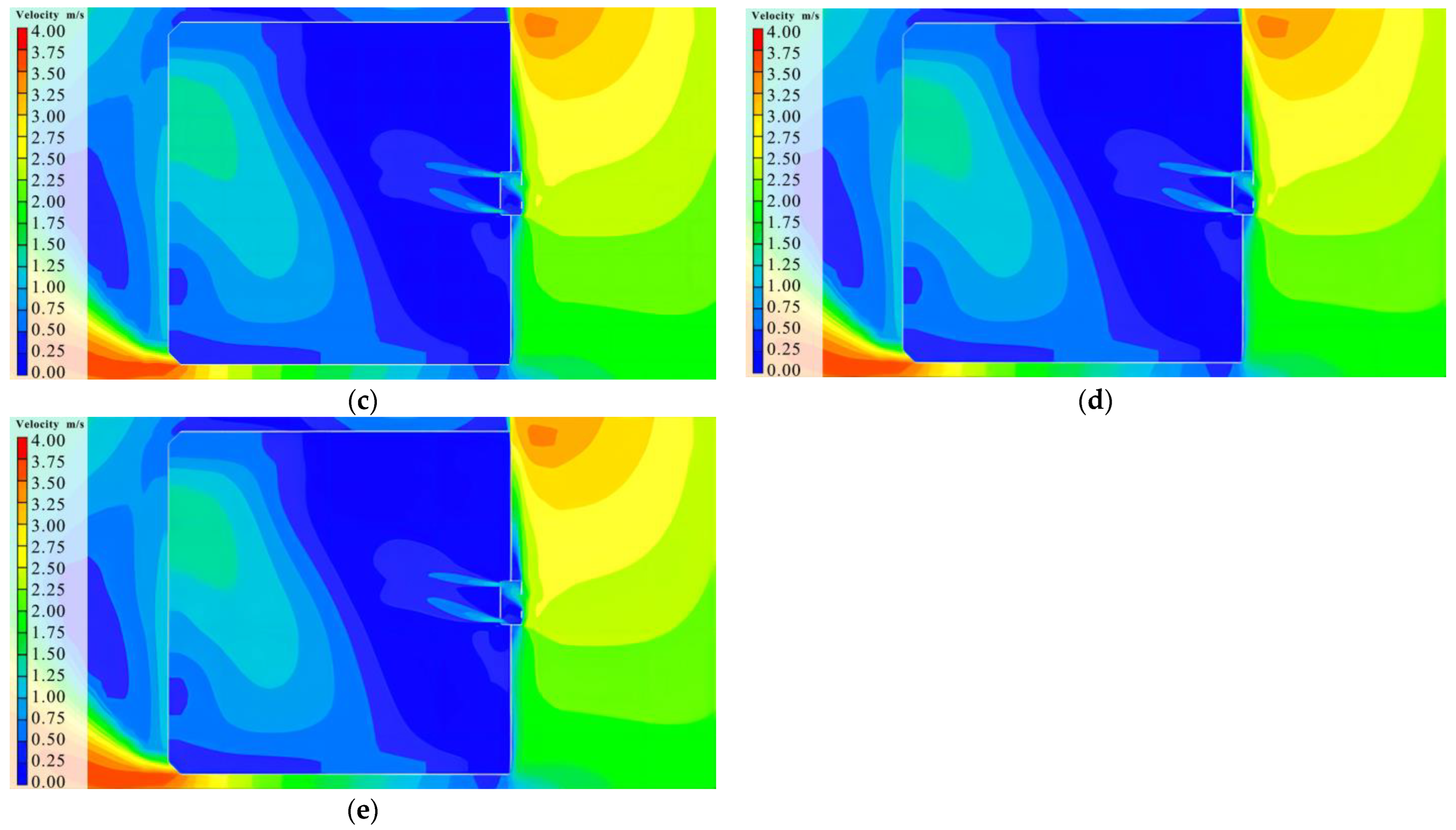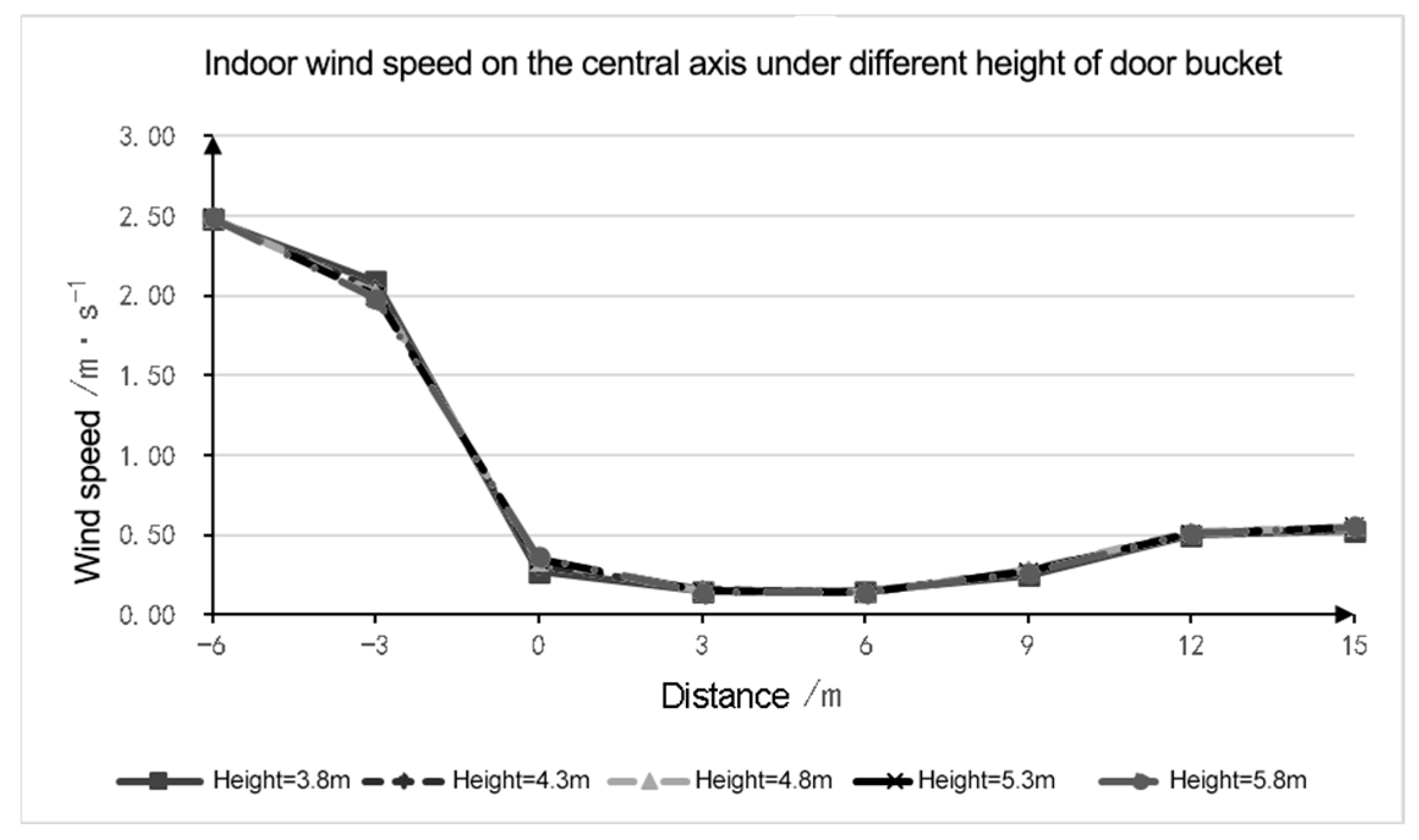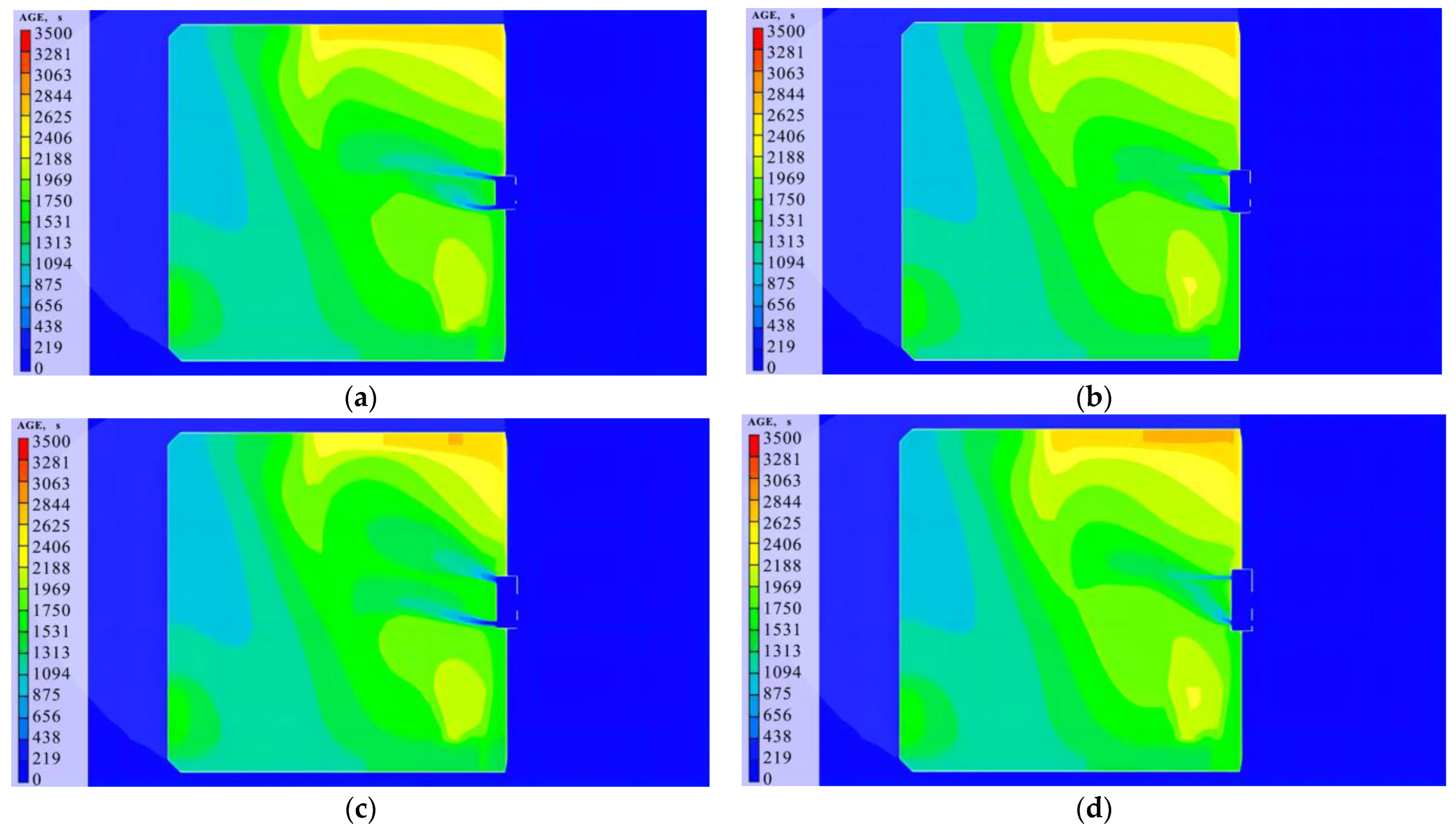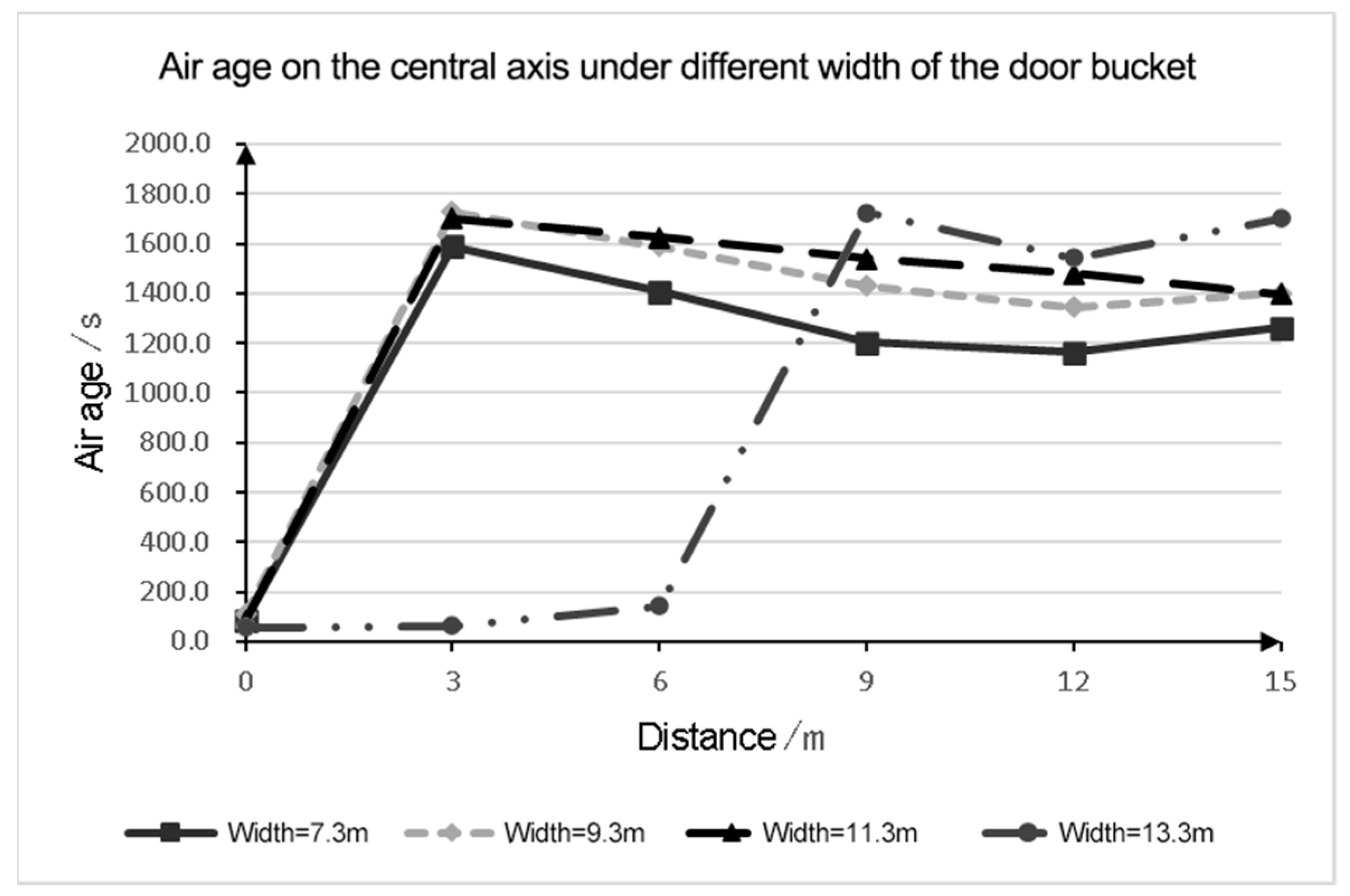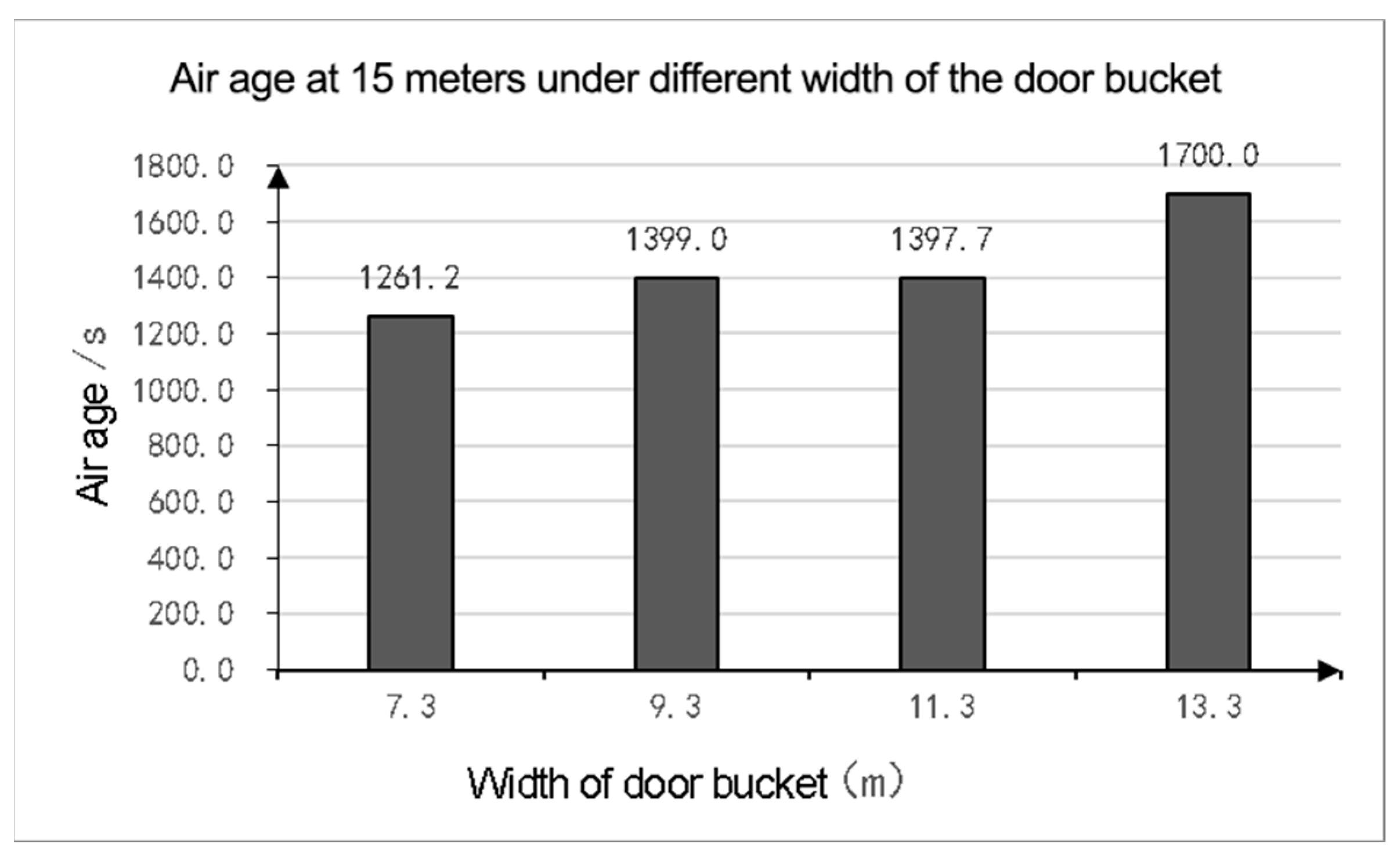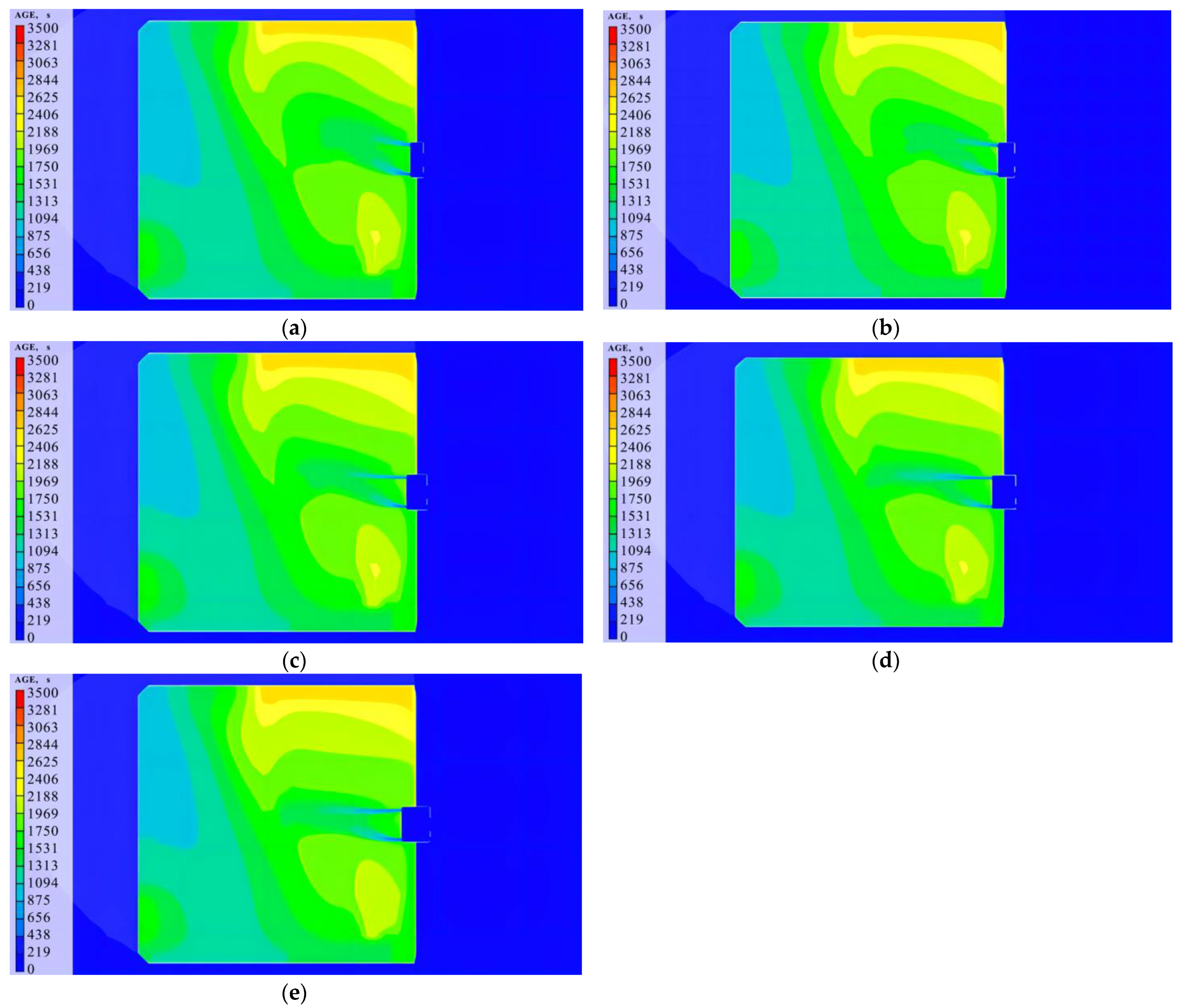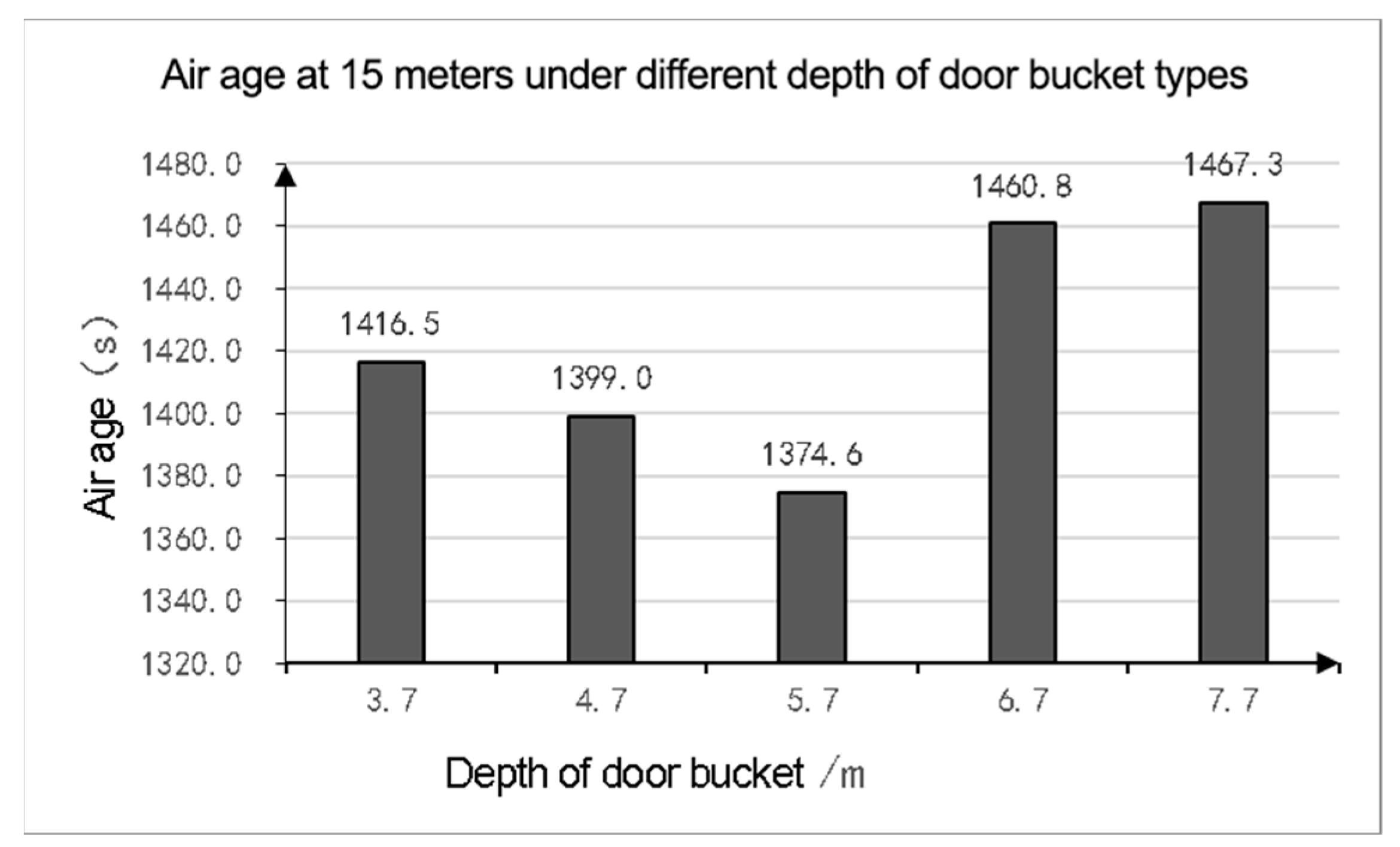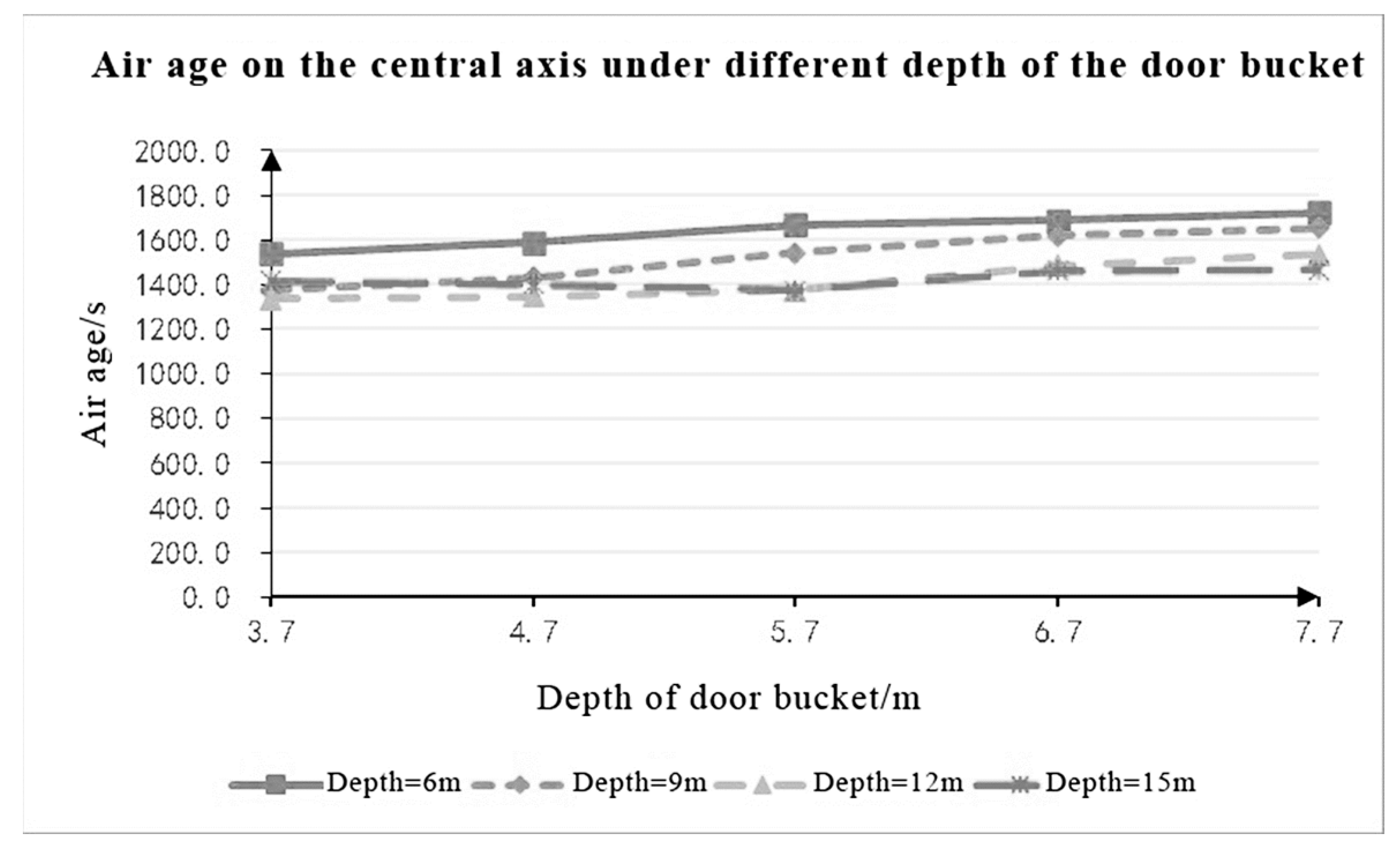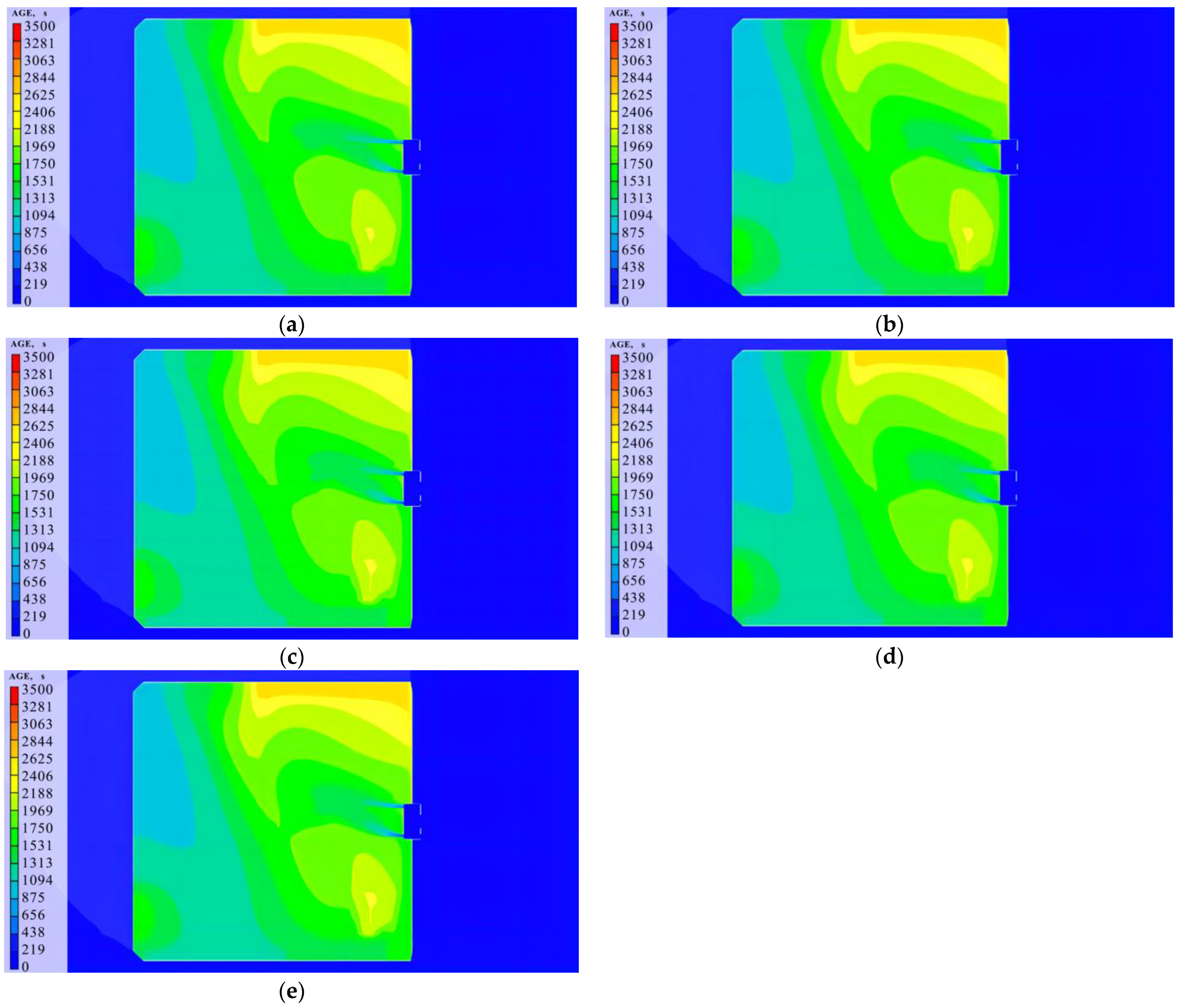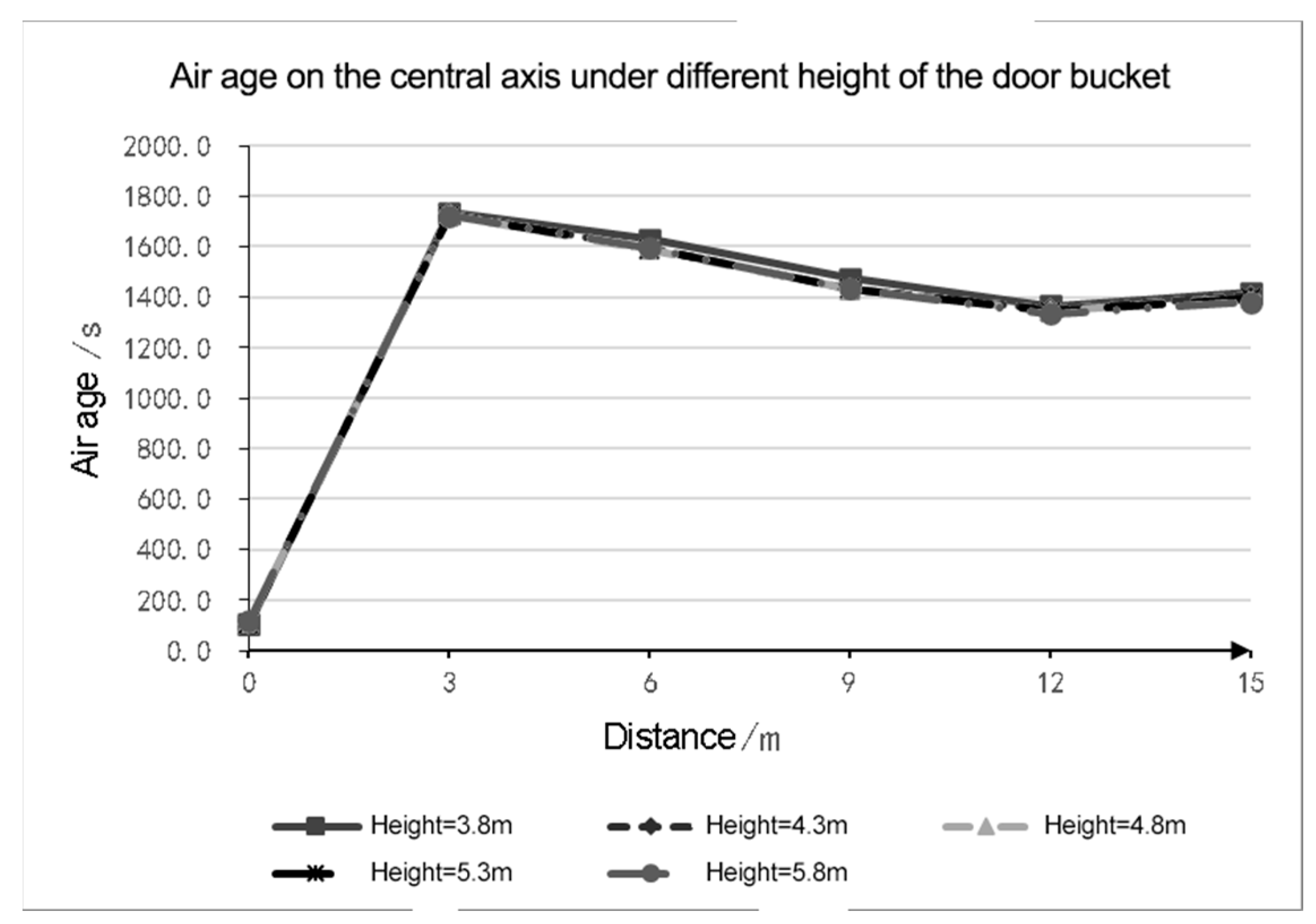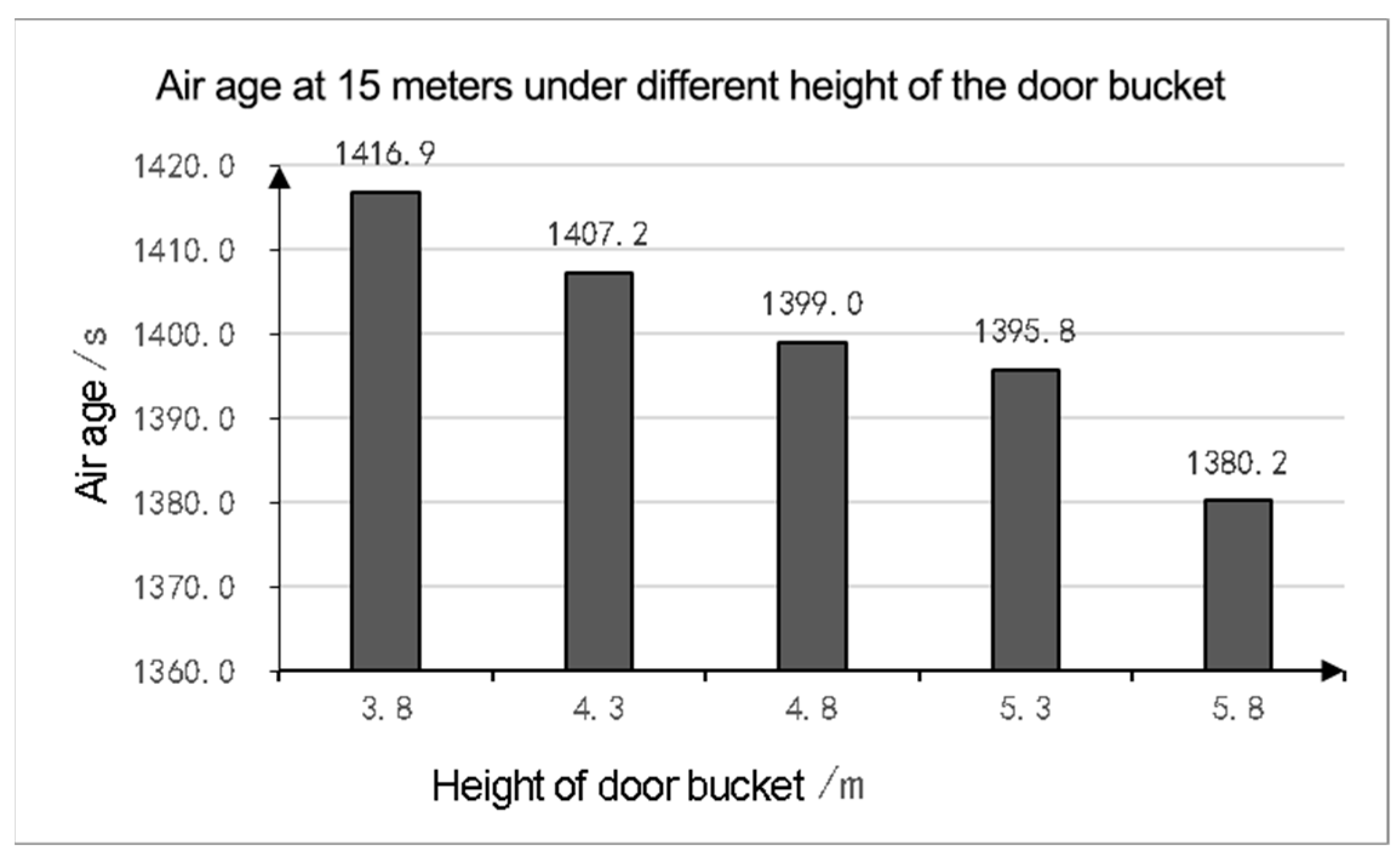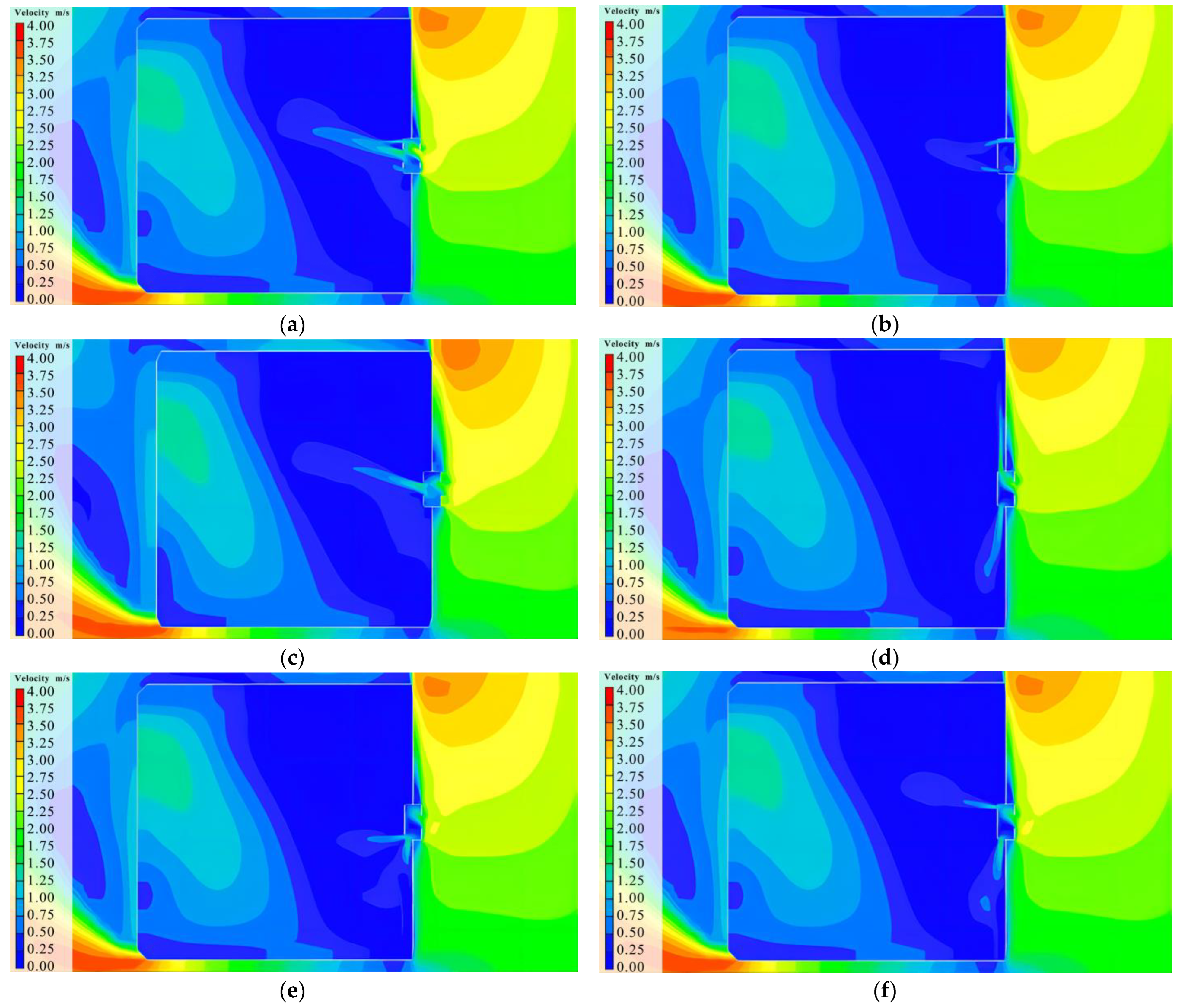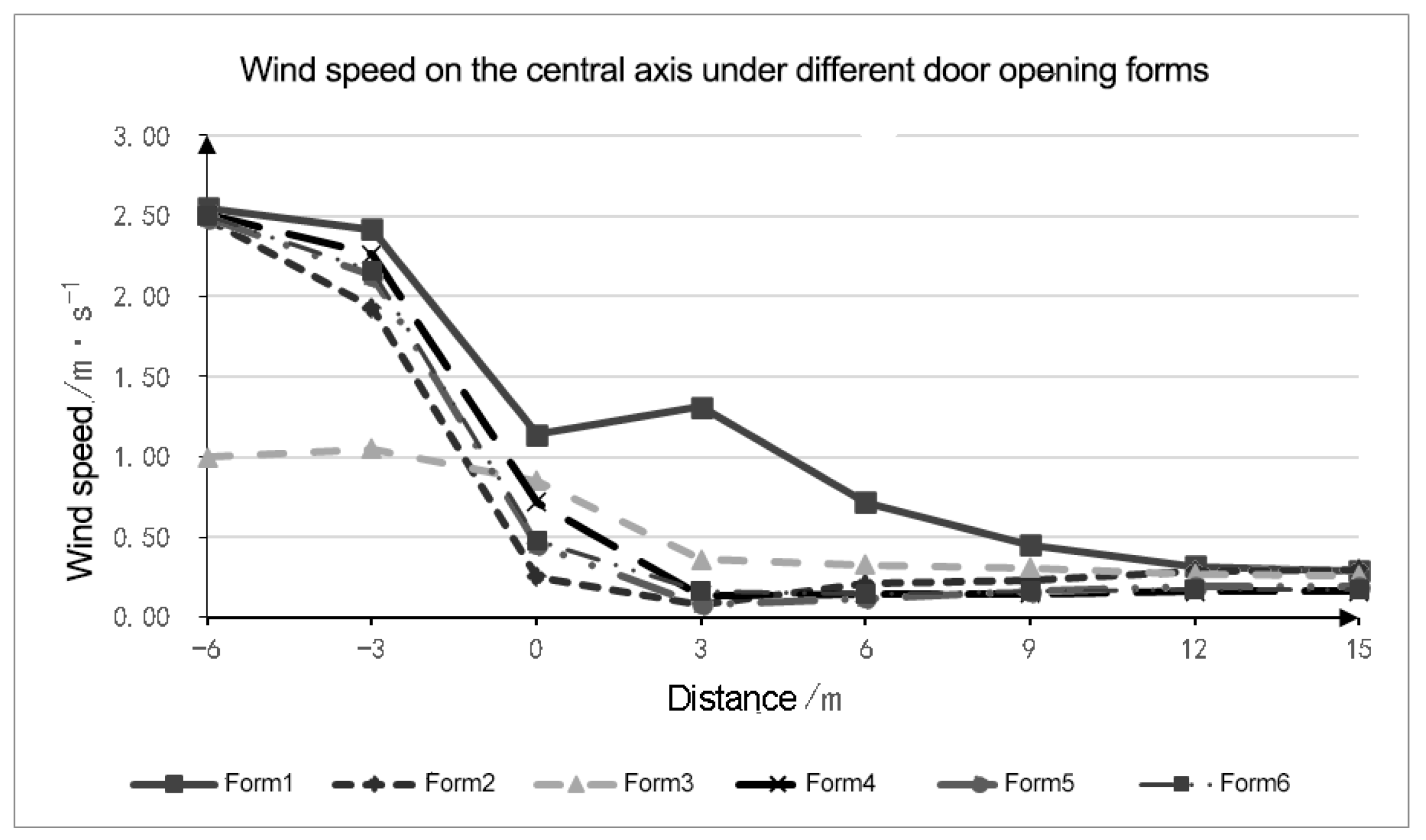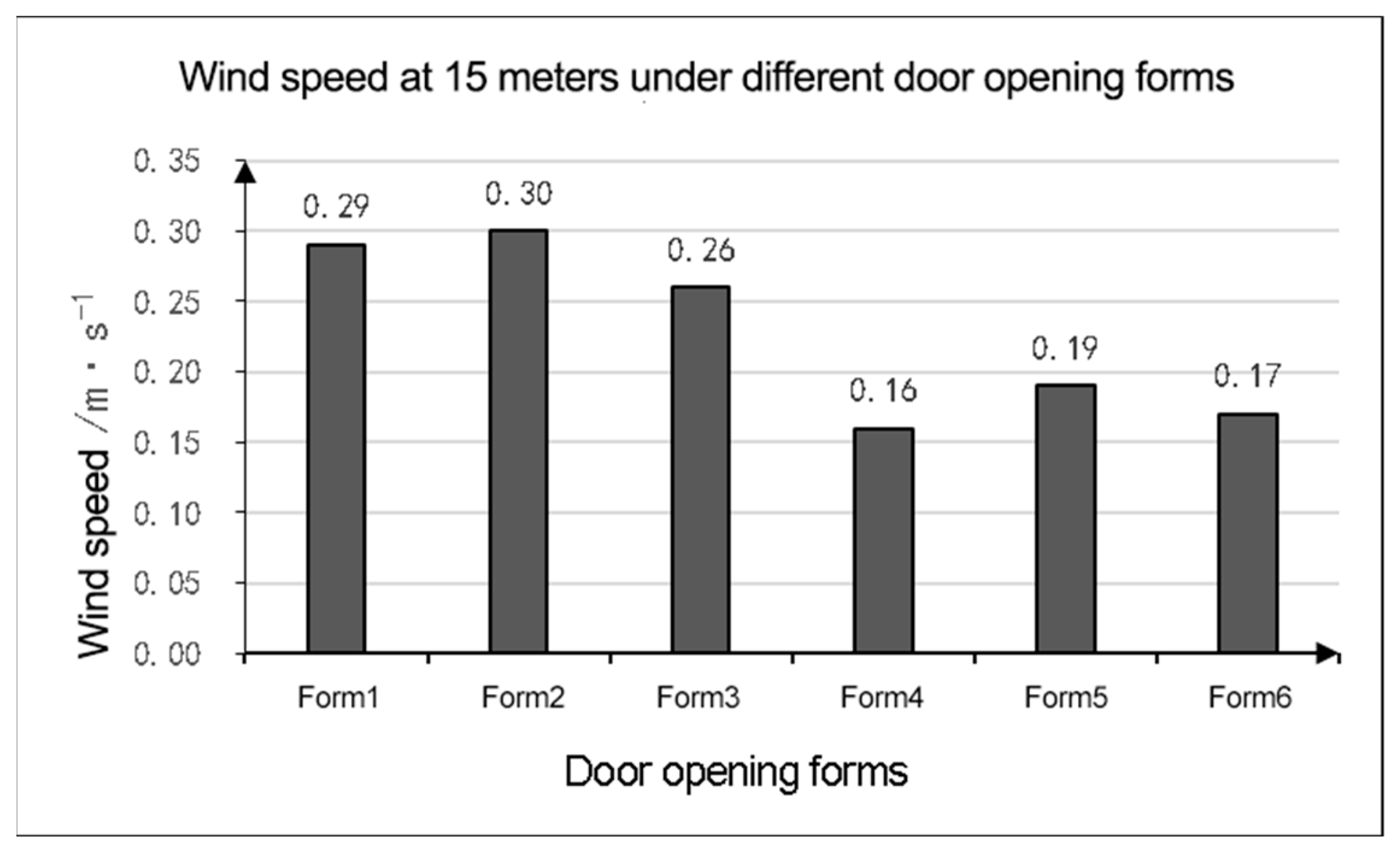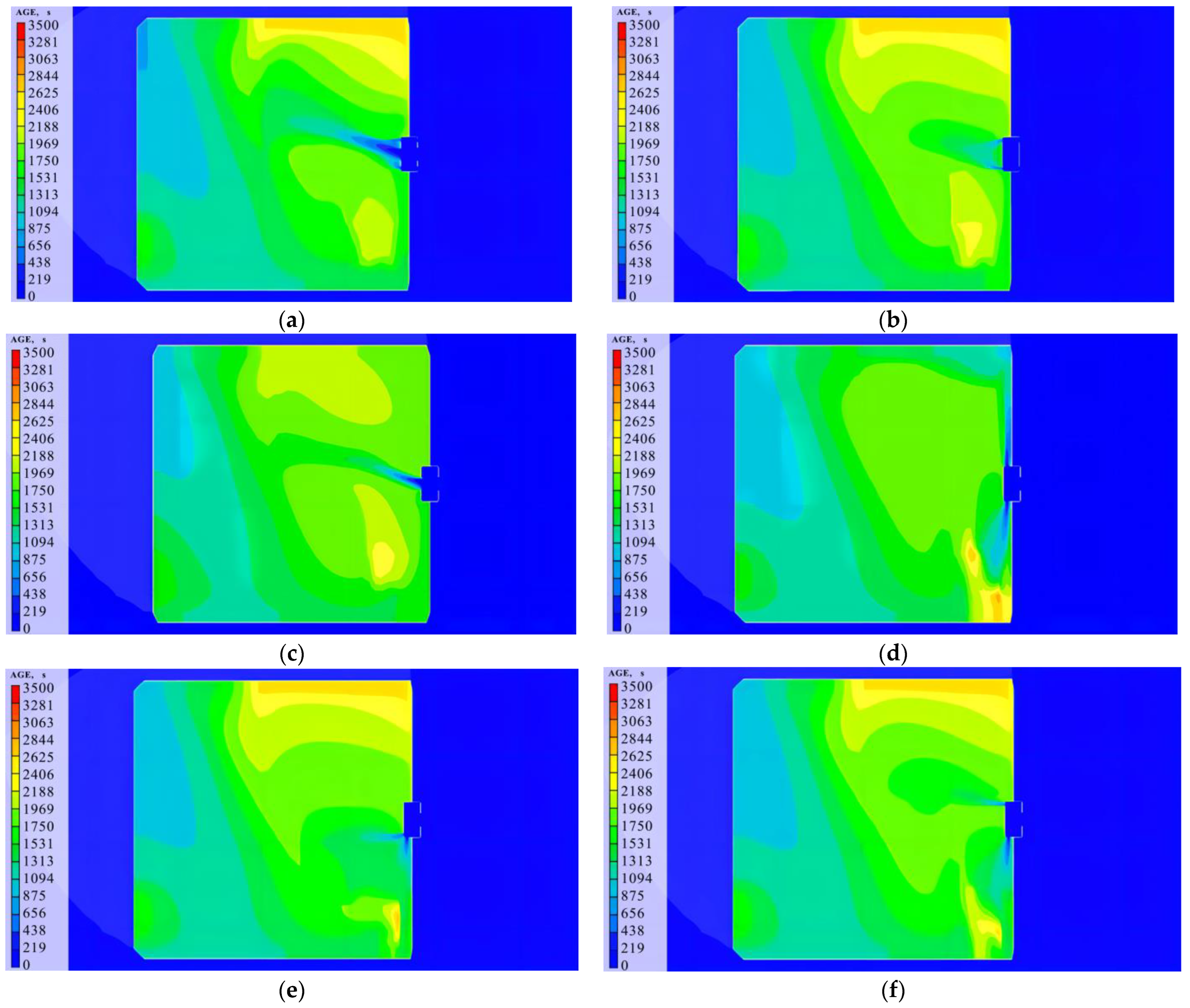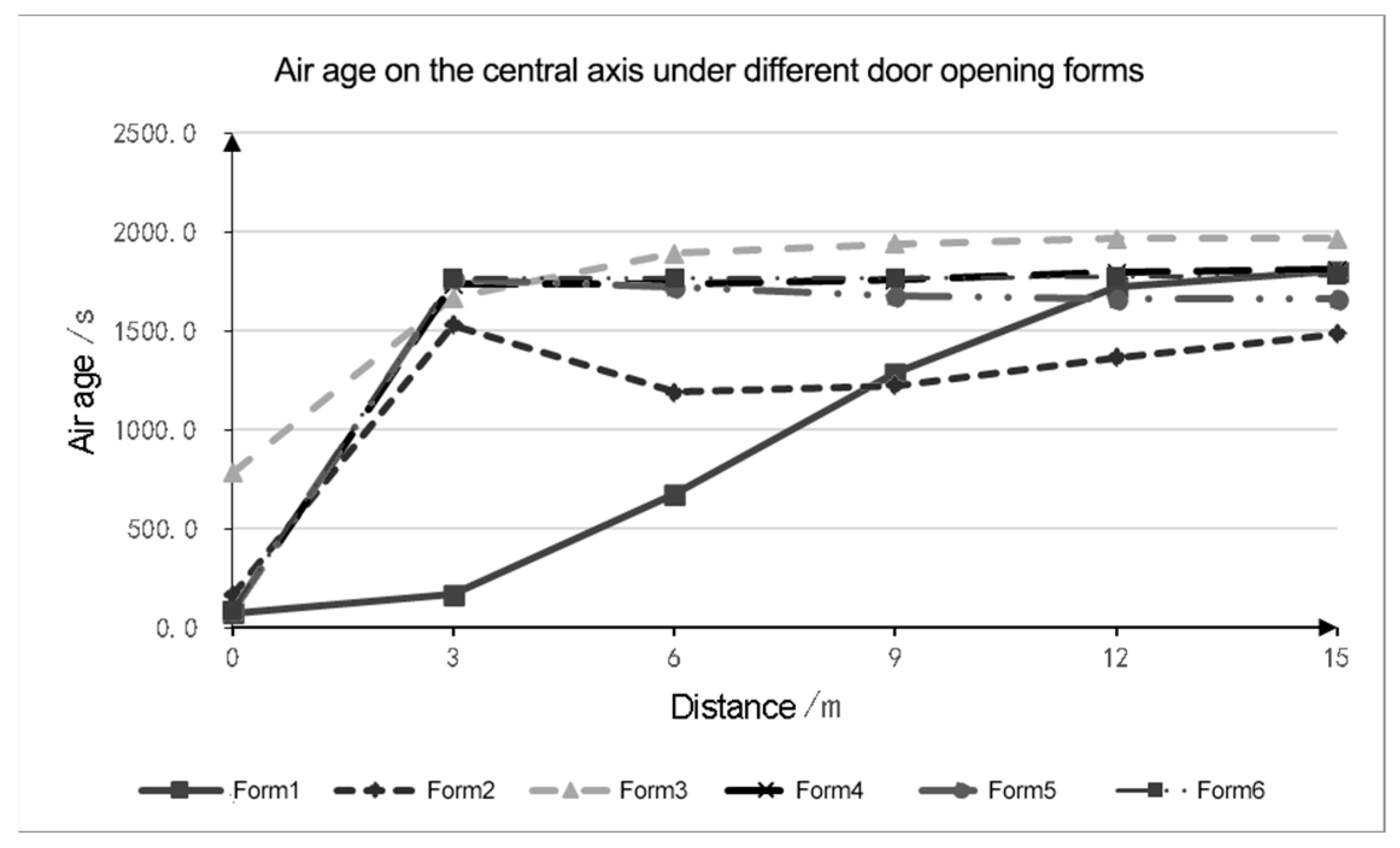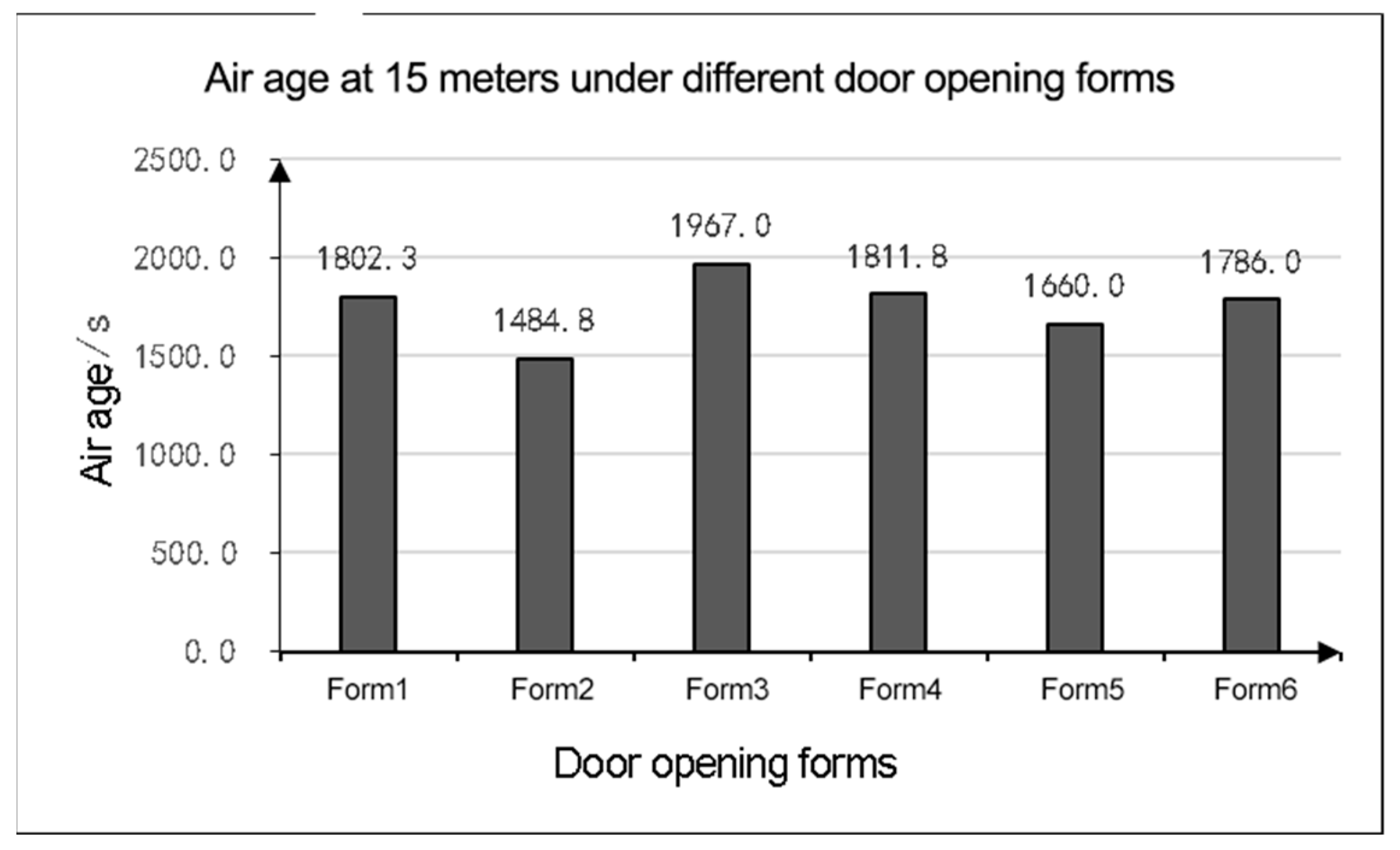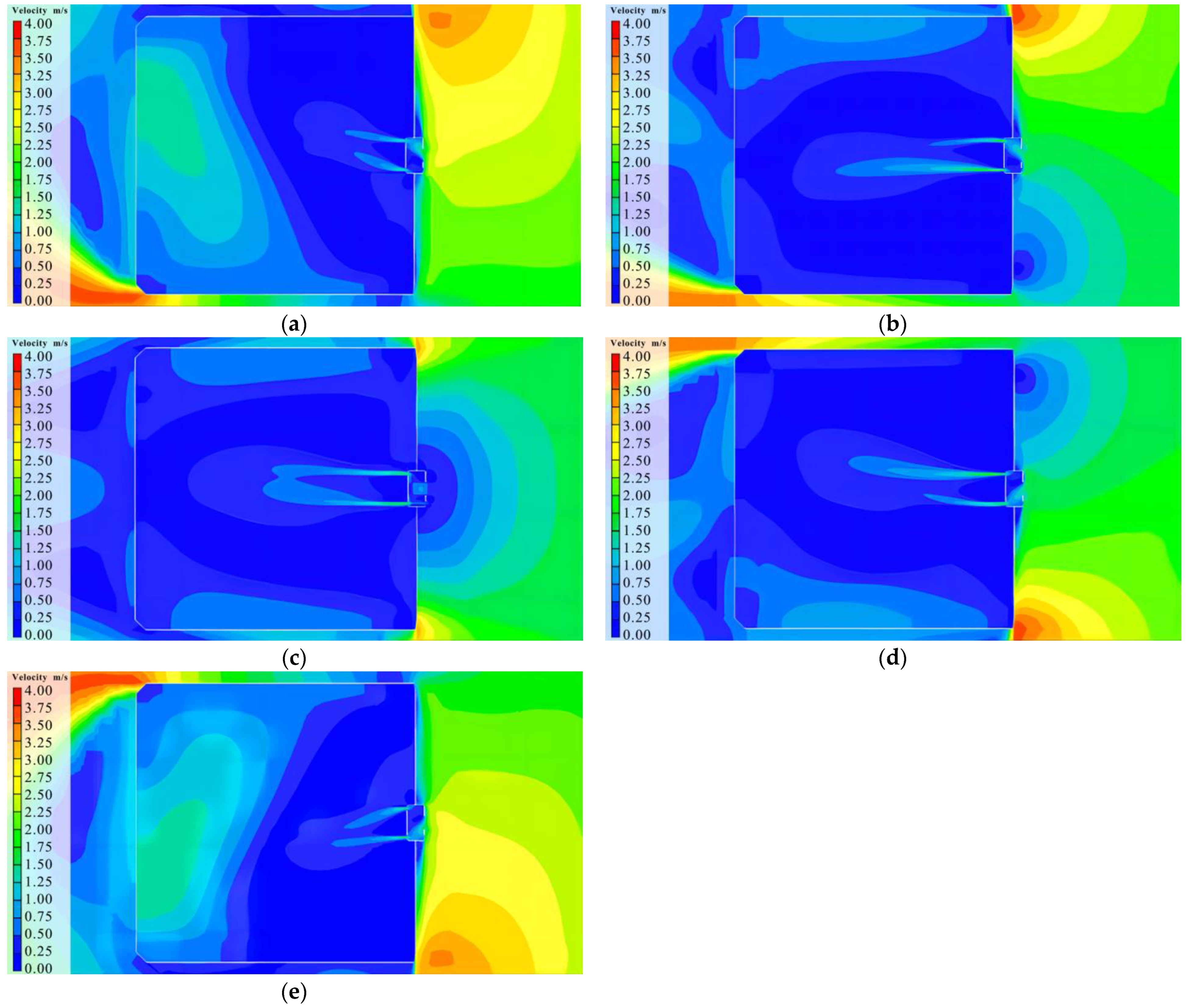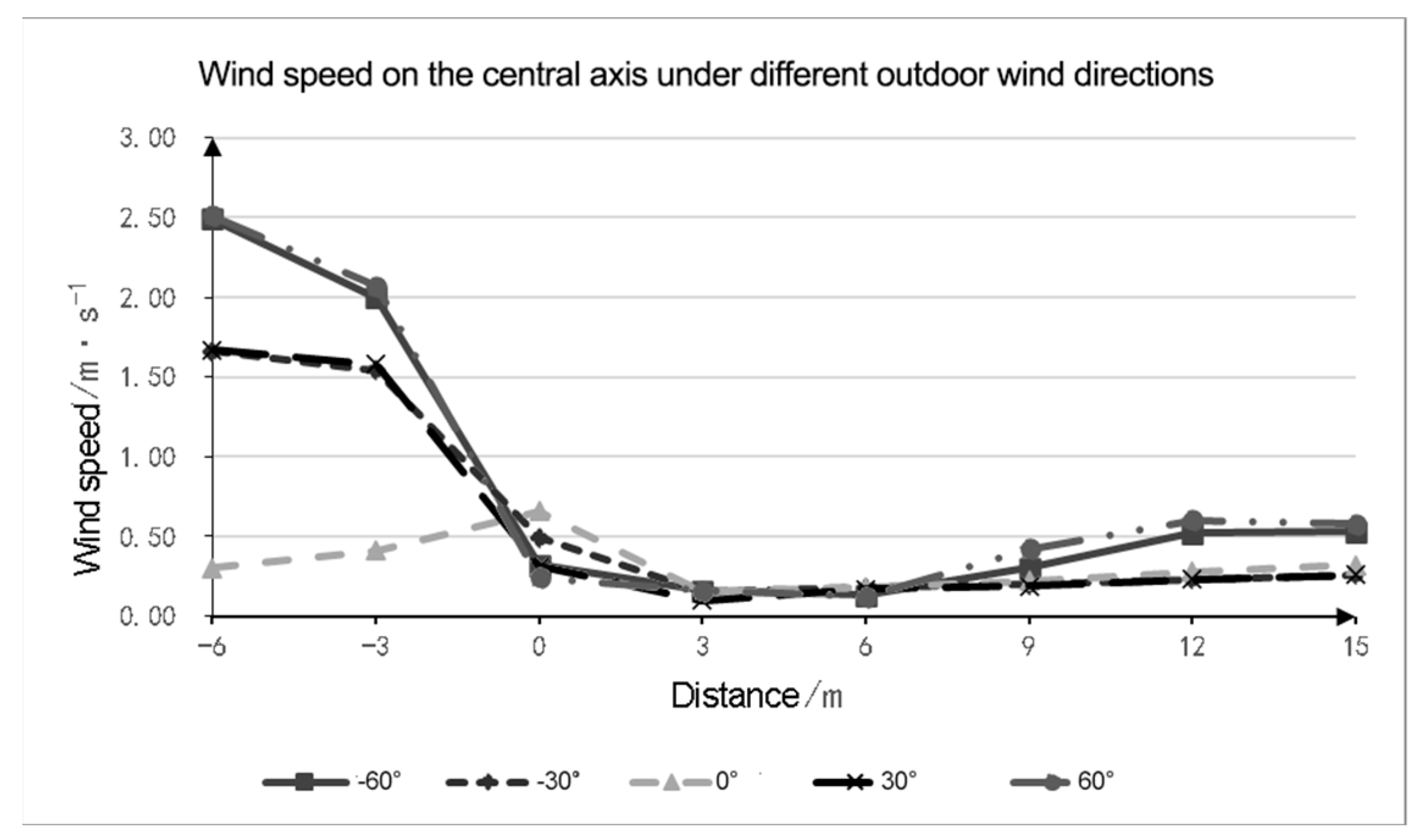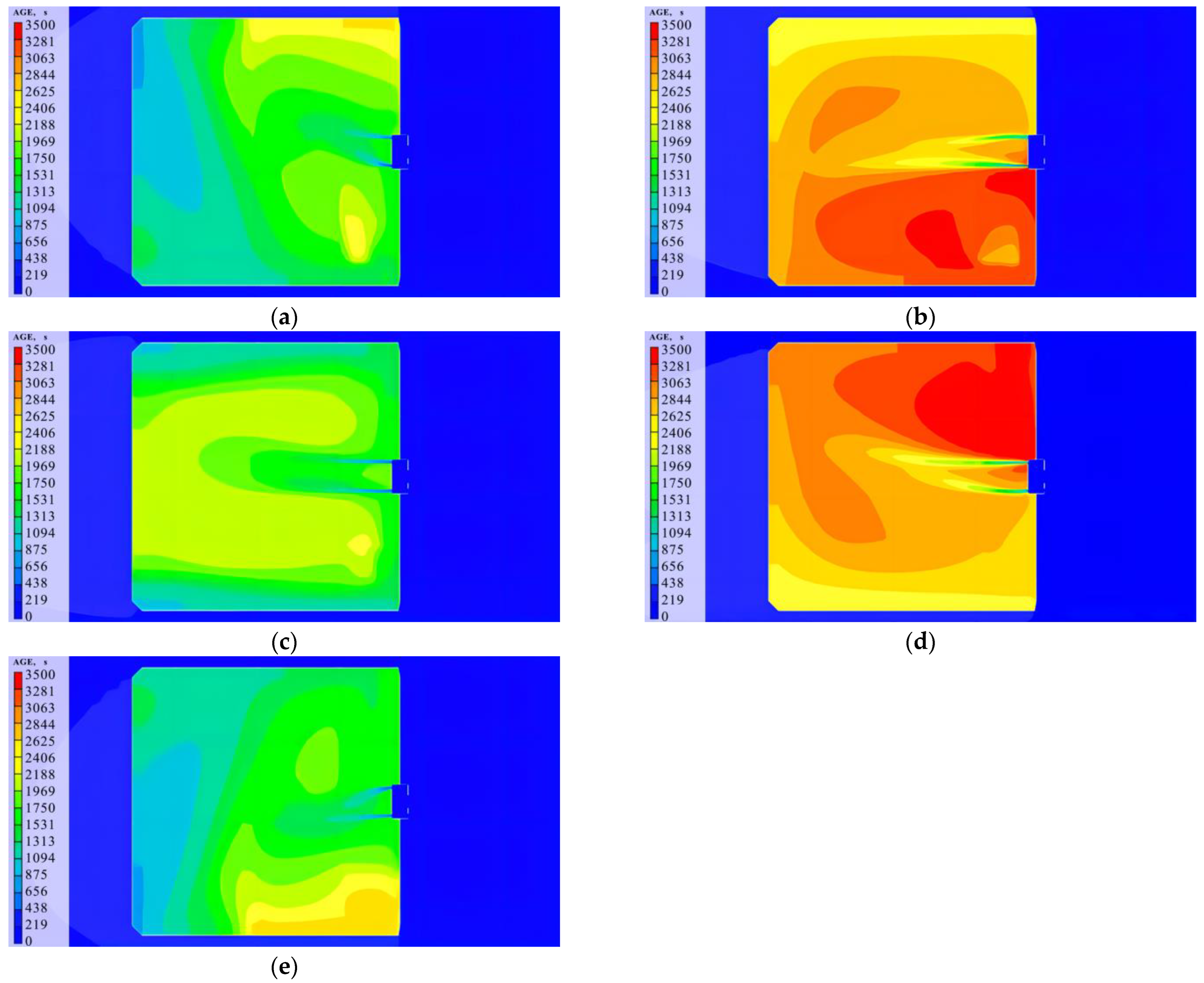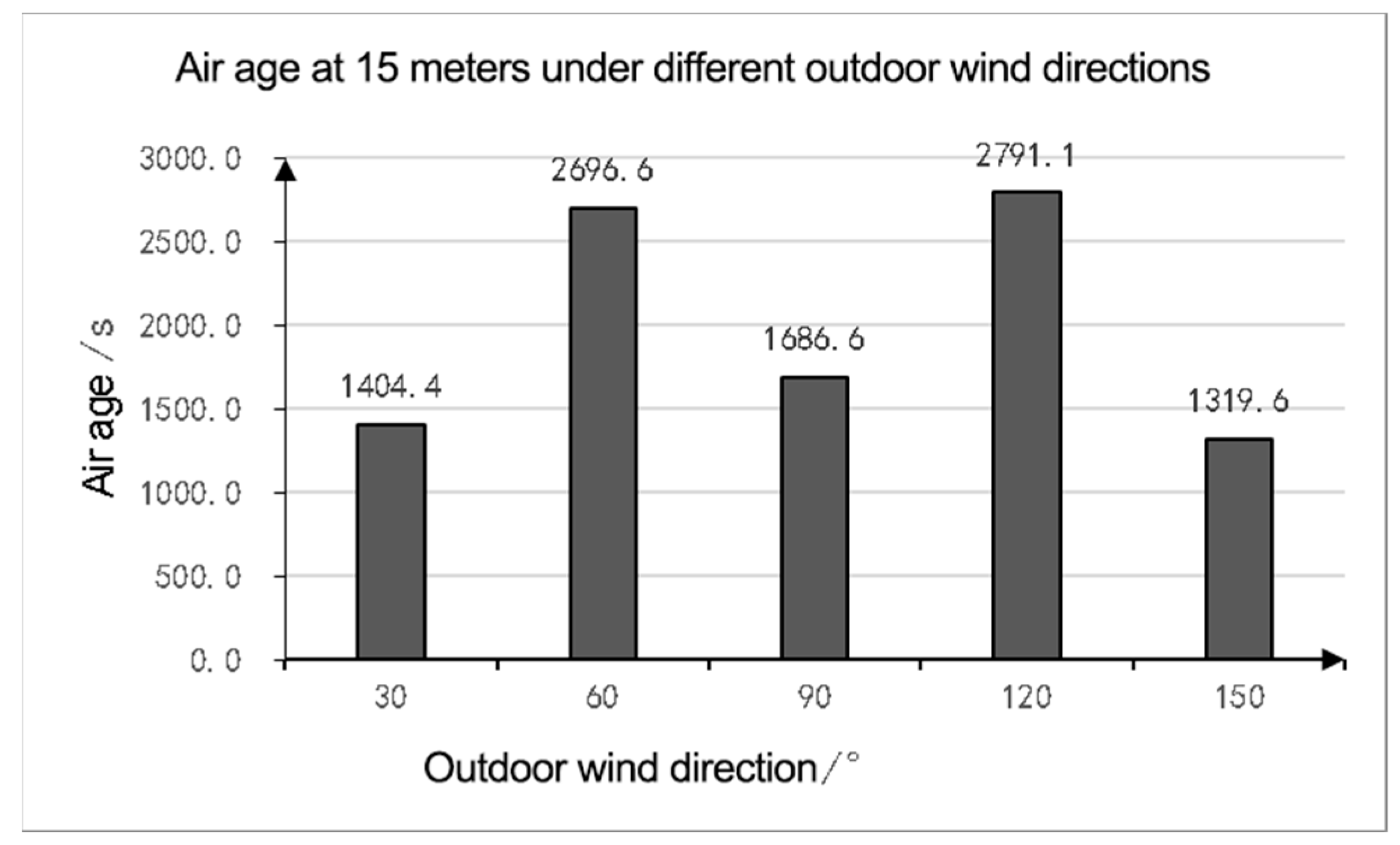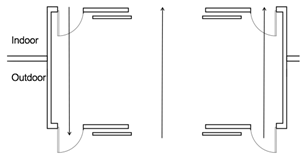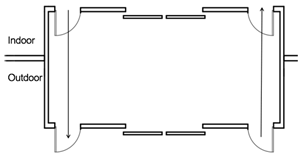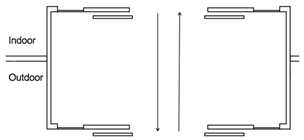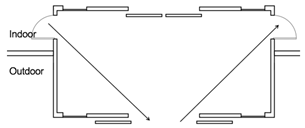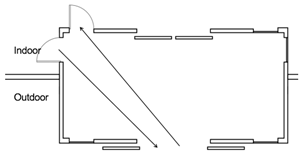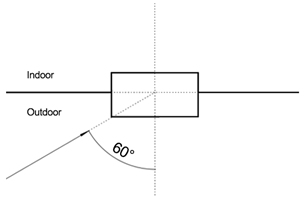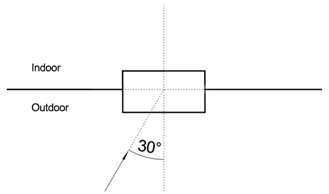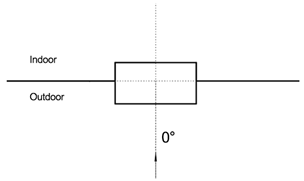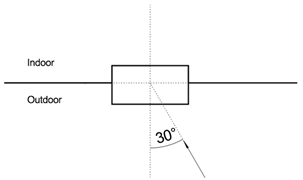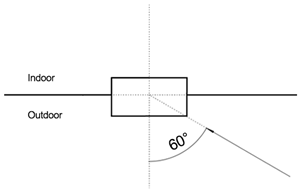Figure 1.
Computational domain and model diagram.
Figure 1.
Computational domain and model diagram.
Figure 2.
Schematic diagram of door bucket opening form.
Figure 2.
Schematic diagram of door bucket opening form.
Figure 3.
Schematic diagram of measurement points.
Figure 3.
Schematic diagram of measurement points.
Figure 4.
Schematic diagrams showing each door bucket type. (a) No door bucket type (NDB). (b) Door bucket built-in type (DBB). (c) Door bucket mid-mounted type (DBM). (d) Door bucket external type (DBE).
Figure 4.
Schematic diagrams showing each door bucket type. (a) No door bucket type (NDB). (b) Door bucket built-in type (DBB). (c) Door bucket mid-mounted type (DBM). (d) Door bucket external type (DBE).
Figure 5.
Wind speed at the center of the door bucket when the skylight was open or closed.
Figure 5.
Wind speed at the center of the door bucket when the skylight was open or closed.
Figure 6.
Simulated wind speed cloud diagram at a height of 1.5 m.
Figure 6.
Simulated wind speed cloud diagram at a height of 1.5 m.
Figure 7.
Wind speed distributions at a height of 1.5 m under different door bucket types. (a) Wind speed cloud diagram at a height of 1.5 m for NDB. (b) Wind speed cloud diagram at a height of 1.5 m for DBB. (c) Wind speed cloud diagram at a height of 1.5 m for DBM. (d) Wind speed cloud diagram at a height of 1.5 m for DBE.
Figure 7.
Wind speed distributions at a height of 1.5 m under different door bucket types. (a) Wind speed cloud diagram at a height of 1.5 m for NDB. (b) Wind speed cloud diagram at a height of 1.5 m for DBB. (c) Wind speed cloud diagram at a height of 1.5 m for DBM. (d) Wind speed cloud diagram at a height of 1.5 m for DBE.
Figure 8.
Changes in wind speed on the central axis of the door bucket under different door bucket types.
Figure 8.
Changes in wind speed on the central axis of the door bucket under different door bucket types.
Figure 9.
Indoor wind speed at 15 m under different door bucket types.
Figure 9.
Indoor wind speed at 15 m under different door bucket types.
Figure 10.
Air age distributions at a height of 1.5 m under different door bucket types. (a) Air age cloud diagram at a height of 1.5 m for NDB. (b) Air age cloud diagram at a height of 1.5 m for DBB. (c) Air age cloud diagram at a height of 1.5 m for DBM. (d) Air age cloud diagram at a height of 1.5 m for DBE.
Figure 10.
Air age distributions at a height of 1.5 m under different door bucket types. (a) Air age cloud diagram at a height of 1.5 m for NDB. (b) Air age cloud diagram at a height of 1.5 m for DBB. (c) Air age cloud diagram at a height of 1.5 m for DBM. (d) Air age cloud diagram at a height of 1.5 m for DBE.
Figure 11.
Changes in air age on the central axis of the door bucket under different door bucket types.
Figure 11.
Changes in air age on the central axis of the door bucket under different door bucket types.
Figure 12.
Indoor air age at 15 m under different door bucket types.
Figure 12.
Indoor air age at 15 m under different door bucket types.
Figure 13.
Wind speed distribution at a height of 1.5 m under different door bucket widths. (a) Wind speed cloud diagram at a height of 1.5 m with a door bucket width of 7.3 m. (b) Wind speed cloud diagram at a height of 1.5 m with a door bucket width of 9.3 m. (c) Wind speed cloud diagram at a height of 1.5 m with a door bucket width of 11.3 m. (d) Wind speed cloud diagram at a height of 1.5 m with a door bucket width of 13.3 m.
Figure 13.
Wind speed distribution at a height of 1.5 m under different door bucket widths. (a) Wind speed cloud diagram at a height of 1.5 m with a door bucket width of 7.3 m. (b) Wind speed cloud diagram at a height of 1.5 m with a door bucket width of 9.3 m. (c) Wind speed cloud diagram at a height of 1.5 m with a door bucket width of 11.3 m. (d) Wind speed cloud diagram at a height of 1.5 m with a door bucket width of 13.3 m.
Figure 14.
Changes in wind speed on the central axis of the door bucket under different door bucket widths.
Figure 14.
Changes in wind speed on the central axis of the door bucket under different door bucket widths.
Figure 15.
Indoor wind speeds at 15 m with different door bucket widths.
Figure 15.
Indoor wind speeds at 15 m with different door bucket widths.
Figure 16.
Wind speed distribution at a height of 1.5 m under different door bucket depths. (a) Wind speed cloud diagram at a height of 1.5 m with a door bucket depth of 3.7 m. (b) Wind speed cloud diagram at a height of 1.5 m with a door bucket depth of 4.7 m. (c) Wind speed cloud diagram at a height of 1.5 m with a door bucket depth of 5.7 m. (d) Wind speed cloud diagram at a height of 1.5 m with a door bucket depth of 6.7 m. (e) Wind speed cloud diagram at a height of 1.5 m with a door bucket depth of 7.7 m.
Figure 16.
Wind speed distribution at a height of 1.5 m under different door bucket depths. (a) Wind speed cloud diagram at a height of 1.5 m with a door bucket depth of 3.7 m. (b) Wind speed cloud diagram at a height of 1.5 m with a door bucket depth of 4.7 m. (c) Wind speed cloud diagram at a height of 1.5 m with a door bucket depth of 5.7 m. (d) Wind speed cloud diagram at a height of 1.5 m with a door bucket depth of 6.7 m. (e) Wind speed cloud diagram at a height of 1.5 m with a door bucket depth of 7.7 m.
Figure 17.
Changes in wind speed on the central axis of the door bucket under different door bucket depths.
Figure 17.
Changes in wind speed on the central axis of the door bucket under different door bucket depths.
Figure 18.
Indoor wind speeds at 15 m under different door bucket depths.
Figure 18.
Indoor wind speeds at 15 m under different door bucket depths.
Figure 19.
Wind speed distributions at 1.5 m height under different door bucket heights. (a) Wind speed cloud diagram at a height of 1.5 m with a door bucket height of 3.8 m. (b) Wind speed cloud diagram at a height of 1.5 m with a door bucket height of 4.3 m. (c) Wind speed cloud diagram at a height of 1.5 m with a door bucket height of 4.8 m. (d) Wind speed cloud diagram at a height of 1.5 m with a door bucket height of 5.3 m. (e) Wind speed cloud diagram at a height of 1.5 m with a door bucket height of 5.8 m.
Figure 19.
Wind speed distributions at 1.5 m height under different door bucket heights. (a) Wind speed cloud diagram at a height of 1.5 m with a door bucket height of 3.8 m. (b) Wind speed cloud diagram at a height of 1.5 m with a door bucket height of 4.3 m. (c) Wind speed cloud diagram at a height of 1.5 m with a door bucket height of 4.8 m. (d) Wind speed cloud diagram at a height of 1.5 m with a door bucket height of 5.3 m. (e) Wind speed cloud diagram at a height of 1.5 m with a door bucket height of 5.8 m.
Figure 20.
Changes in wind speed on the central axis of the door bucket under different door bucket heights.
Figure 20.
Changes in wind speed on the central axis of the door bucket under different door bucket heights.
Figure 21.
Air age distributions at a height of 1.5 m under different door bucket widths. (a) Air age cloud diagram at a height of 1.5 m with a door bucket width of 7.3 m. (b) Air age cloud diagram at a height of 1.5 m with a door bucket width of 9.3 m. (c) Air age cloud diagram at a height of 1.5 m with a door bucket width of 11.3 m. (d) Air age cloud diagram at a height of 1.5 m with a door bucket width of 13.3 m.
Figure 21.
Air age distributions at a height of 1.5 m under different door bucket widths. (a) Air age cloud diagram at a height of 1.5 m with a door bucket width of 7.3 m. (b) Air age cloud diagram at a height of 1.5 m with a door bucket width of 9.3 m. (c) Air age cloud diagram at a height of 1.5 m with a door bucket width of 11.3 m. (d) Air age cloud diagram at a height of 1.5 m with a door bucket width of 13.3 m.
Figure 22.
Changes in air age on the central axis of the door bucket under different door bucket widths.
Figure 22.
Changes in air age on the central axis of the door bucket under different door bucket widths.
Figure 23.
Indoor air ages at 15 m under different door bucket width.
Figure 23.
Indoor air ages at 15 m under different door bucket width.
Figure 24.
Air age distribution at 1.5 m height under different door bucket depths. (a) Air age cloud diagram at a height of 1.5 m with a door bucket depth of 3.7 m. (b) Air age cloud diagram at a height of 1.5 m with a door bucket depth of 4.7 m. (c) Air age cloud diagram at a height of 1.5 m with a door bucket depth of 5.7 m. (d) Air age cloud diagram at a height of 1.5 m with a door bucket depth of 6.7 m. (e) Air age cloud diagram at a height of 1.5 m with a door bucket depth of 7.7 m.
Figure 24.
Air age distribution at 1.5 m height under different door bucket depths. (a) Air age cloud diagram at a height of 1.5 m with a door bucket depth of 3.7 m. (b) Air age cloud diagram at a height of 1.5 m with a door bucket depth of 4.7 m. (c) Air age cloud diagram at a height of 1.5 m with a door bucket depth of 5.7 m. (d) Air age cloud diagram at a height of 1.5 m with a door bucket depth of 6.7 m. (e) Air age cloud diagram at a height of 1.5 m with a door bucket depth of 7.7 m.
Figure 25.
Changes in air age on the central axis of the door bucket under different door bucket depth conditions.
Figure 25.
Changes in air age on the central axis of the door bucket under different door bucket depth conditions.
Figure 26.
Air ages at 15 m indoors under different door bucket depths.
Figure 26.
Air ages at 15 m indoors under different door bucket depths.
Figure 27.
Changes in air age at different distances on the central axis of the door bucket.
Figure 27.
Changes in air age at different distances on the central axis of the door bucket.
Figure 28.
Air age distribution at 1.5 m height under different door bucket heights. (a) Air age cloud diagram at a height of 1.5 m with a door bucket height of 3.8 m. (b) Air age cloud diagram at a height of 1.5 m with a door bucket height of 4.3 m. (c) Air age cloud diagram at a height of 1.5 m with a door bucket height of 4.8 m. (d) Air age cloud diagram at a height of 1.5 m with a door bucket height of 5.3 m. (e) Air age cloud diagram at a height of 1.5 m with a door bucket height of 5.8 m.
Figure 28.
Air age distribution at 1.5 m height under different door bucket heights. (a) Air age cloud diagram at a height of 1.5 m with a door bucket height of 3.8 m. (b) Air age cloud diagram at a height of 1.5 m with a door bucket height of 4.3 m. (c) Air age cloud diagram at a height of 1.5 m with a door bucket height of 4.8 m. (d) Air age cloud diagram at a height of 1.5 m with a door bucket height of 5.3 m. (e) Air age cloud diagram at a height of 1.5 m with a door bucket height of 5.8 m.
Figure 29.
Changes in air age on the central axis of the door bucket under different door bucket heights.
Figure 29.
Changes in air age on the central axis of the door bucket under different door bucket heights.
Figure 30.
Indoor air age at 15 m under different door bucket heights.
Figure 30.
Indoor air age at 15 m under different door bucket heights.
Figure 31.
Wind speed distribution at a height of 1.5 m under different door opening modes. (a) Simulation 1: Wind speed cloud diagram at 1.5 m height. (b) Simulation 2: Wind speed cloud diagram at 1.5 m height. (c) Simulation 3: Wind speed cloud diagram at 1.5 m height. (d) Simulation 4: Wind speed cloud diagram at 1.5 m height. (e) Simulation 5: Wind speed cloud diagram at 1.5 m height. (f) Simulation 6: Wind speed cloud diagram at 1.5 m height.
Figure 31.
Wind speed distribution at a height of 1.5 m under different door opening modes. (a) Simulation 1: Wind speed cloud diagram at 1.5 m height. (b) Simulation 2: Wind speed cloud diagram at 1.5 m height. (c) Simulation 3: Wind speed cloud diagram at 1.5 m height. (d) Simulation 4: Wind speed cloud diagram at 1.5 m height. (e) Simulation 5: Wind speed cloud diagram at 1.5 m height. (f) Simulation 6: Wind speed cloud diagram at 1.5 m height.
Figure 32.
Changes in wind speed on the central axis of the door bucket under different door opening modes.
Figure 32.
Changes in wind speed on the central axis of the door bucket under different door opening modes.
Figure 33.
Indoor wind speeds at 15 m under different door opening modes.
Figure 33.
Indoor wind speeds at 15 m under different door opening modes.
Figure 34.
Air age distribution at 1.5 m height under different door opening modes. (a) Simulation 1: Air age cloud image at a height of 1.5 m. (b) Simulation 2: Air age cloud image at a height of 1.5 m. (c) Simulation 3: Air age cloud image at a height of 1.5 m. (d) Simulation 4: Air age cloud image at a height of 1.5 m. (e) Simulation 5: Air age cloud image at a height of 1.5 m. (f) Simulation 6: Air age cloud image at a height of 1.5 m.
Figure 34.
Air age distribution at 1.5 m height under different door opening modes. (a) Simulation 1: Air age cloud image at a height of 1.5 m. (b) Simulation 2: Air age cloud image at a height of 1.5 m. (c) Simulation 3: Air age cloud image at a height of 1.5 m. (d) Simulation 4: Air age cloud image at a height of 1.5 m. (e) Simulation 5: Air age cloud image at a height of 1.5 m. (f) Simulation 6: Air age cloud image at a height of 1.5 m.
Figure 35.
Changes in air age on the central axis of the door bucket under different door opening forms.
Figure 35.
Changes in air age on the central axis of the door bucket under different door opening forms.
Figure 36.
Indoor air ages at 15 m under different door opening modes.
Figure 36.
Indoor air ages at 15 m under different door opening modes.
Figure 37.
Wind speed distribution at a height of 1.5 m under different outdoor wind directions. (a) Cloud diagram of wind speed at a height of 1.5 m when the outdoor wind direction was at an angle of 60°. (b) Cloud diagram of wind speed at a height of 1.5 m when the outdoor wind direction was at an angle of 30°. (c) Cloud diagram of wind speed at a height of 1.5 m when the outdoor wind direction was at an angle of 0°. (d) Cloud diagram of wind speed at a height of 1.5 m when the outdoor wind direction was at an angle of −30°. (e) Cloud diagram of wind speed at a height of 1.5 m when the outdoor wind direction was at an angle of −60°.
Figure 37.
Wind speed distribution at a height of 1.5 m under different outdoor wind directions. (a) Cloud diagram of wind speed at a height of 1.5 m when the outdoor wind direction was at an angle of 60°. (b) Cloud diagram of wind speed at a height of 1.5 m when the outdoor wind direction was at an angle of 30°. (c) Cloud diagram of wind speed at a height of 1.5 m when the outdoor wind direction was at an angle of 0°. (d) Cloud diagram of wind speed at a height of 1.5 m when the outdoor wind direction was at an angle of −30°. (e) Cloud diagram of wind speed at a height of 1.5 m when the outdoor wind direction was at an angle of −60°.
Figure 38.
Wind speed changes on the central axis of the door bucket under different outdoor wind directions.
Figure 38.
Wind speed changes on the central axis of the door bucket under different outdoor wind directions.
Figure 39.
Indoor wind speeds at 15 m under different outdoor wind directions.
Figure 39.
Indoor wind speeds at 15 m under different outdoor wind directions.
Figure 40.
Air age distribution at 1.5 m height under different outdoor wind directions. (a) Air age cloud diagram at a height of 1.5 m with an outdoor wind direction angle of 60°. (b) Air age cloud diagram at a height of 1.5 m with an outdoor wind direction angle of 30°. (c) Air age cloud diagram at a height of 1.5 m with an outdoor wind direction angle of 0°. (d) Air age cloud diagram at a height of 1.5 m with an outdoor wind direction angle of −30°. (e) Air age cloud diagram at a height of 1.5 m with an outdoor wind direction angle of −60°.
Figure 40.
Air age distribution at 1.5 m height under different outdoor wind directions. (a) Air age cloud diagram at a height of 1.5 m with an outdoor wind direction angle of 60°. (b) Air age cloud diagram at a height of 1.5 m with an outdoor wind direction angle of 30°. (c) Air age cloud diagram at a height of 1.5 m with an outdoor wind direction angle of 0°. (d) Air age cloud diagram at a height of 1.5 m with an outdoor wind direction angle of −30°. (e) Air age cloud diagram at a height of 1.5 m with an outdoor wind direction angle of −60°.
Figure 41.
Air age changes on the central axis of the door bucket under different outdoor wind directions.
Figure 41.
Air age changes on the central axis of the door bucket under different outdoor wind directions.
Figure 42.
Indoor air ages at 15 m under different outdoor wind directions.
Figure 42.
Indoor air ages at 15 m under different outdoor wind directions.
Table 1.
Indoor design parameters for air conditioning in areas with extended stays by people.
Table 1.
Indoor design parameters for air conditioning in areas with extended stays by people.
| Category | Thermal Comfort Level | Temperature (°C) | Relative Humidity (%) | Wind Speed (m/s) |
|---|
| Heating conditions | Level I | 22–24 | ≥30 | ≤0.2 |
| Level II | 18–22 | — | ≤0.2 |
| Cooling conditions | Level I | 24–26 | 40–60 | ≤0.25 |
| Level II | 26–28 | ≤70 | ≤0.3 |
Table 2.
Effects of wind speed on human comfort.
Table 2.
Effects of wind speed on human comfort.
| Wind Speed (m/s) | Impact on Human Comfort |
|---|
| 0–0.25 | Wind speed too weak to notice |
| 0.25–0.5 | Less windy and comfortable |
| 0.5–1.0 | Moderate wind speed, more comfortable |
| 1.0–1.5 | Windy and slightly uncomfortable |
| >1.5 | Excessive wind speed and obvious discomfort |
Table 3.
Indoor wind speed evaluation criteria.
Table 3.
Indoor wind speed evaluation criteria.
| Wind Speed (m/s) | Comfort |
|---|
| 0–0.3 | Comfort |
| 0.3–0.6 | Moderate |
| 0.6–1.0 | Slight discomfort |
| >1.0 | Discomfort |
Table 4.
Xianyang climate conditions given in the “Design specifications for heating, ventilation and air conditioning in civil buildings”.
Table 4.
Xianyang climate conditions given in the “Design specifications for heating, ventilation and air conditioning in civil buildings”.
| City | Season | Calculated Ventilation Outdoor Temperature (°C) | Average Outdoor Wind Speed (m/s) | Maximum Wind Direction | Outdoor Atmospheric Pressure (hPa) |
|---|
| Xianyang | Summer | 29.9 | 1.7 | WNW | 953.1 |
| Winter | −0.4 | 1.4 | NW | 971.7 |
Table 6.
Simulation parameter settings for different door dimensions (m).
Table 6.
Simulation parameter settings for different door dimensions (m).
| Serial Number | Simulated Width | Simulation Depth | Simulated Height |
|---|
| Case 1 | 9.3 (original) | 4.7 (original) | 4.8 (original) |
| Case 2 | 7.3 | 4.7 (original) | 4.8 (original) |
| Case 3 | 11.3 | 4.7 (original) | 4.8 (original) |
| Case 4 | 13.3 | 4.7 (original) | 4.8 (original) |
| Case 5 | 9.3 (original) | 3.7 | 4.8 (original) |
| Case 6 | 9.3 (original) | 5.7 | 4.8 (original) |
| Case 7 | 9.3 (original) | 6.7 | 4.8 (original) |
| Case 8 | 9.3 (original) | 7.7 | 4.8 (original) |
| Case 9 | 9.3 (original) | 4.7 (original) | 3.8 |
| Case 10 | 9.3 (original) | 4.7 (original) | 4.3 |
| Case 11 | 9.3 (original) | 4.7 (original) | 5.3 |
| Case 12 | 9.3 (original) | 4.7 (original) | 5.8 |
Table 7.
Six types of door-opening modes.
Table 8.
Simulated wind directions.
Table 9.
Comparison of wind speeds in field tests and simulation results.
Table 9.
Comparison of wind speeds in field tests and simulation results.
| Distance (m) | 0 | 3 | 6 | 9 | 12 | 15 |
|---|
| Measured wind speed (m/s) | 0.62 | 0.24 | 0.21 | 0.14 | 0.09 | 0.09 |
| Simulated wind speed (m/s) | 0.62 | 0.27 | 0.17 | 0.09 | 0.04 | 0.03 |
Table 10.
Changes in wind speed change on the central axis of the door bucket (unit: m/s).
Table 10.
Changes in wind speed change on the central axis of the door bucket (unit: m/s).
| Distance (m) | −6 | −3 | 0 | 3 | 6 | 9 | 12 | 15 |
|---|
| NDB | 2.60 | 2.77 | 3.13 | 1.38 | 0.39 | 0.37 | 0.38 | 0.31 |
| DBB | 2.37 | 2.31 | 1.68 | 0.32 | 0.13 | 0.15 | 0.36 | 0.49 |
| DBM | 2.49 | 2.02 | 0.34 | 0.15 | 0.14 | 0.28 | 0.52 | 0.55 |
| DBE | 1.93 | 0.67 | 0.18 | 0.13 | 0.29 | 0.51 | 0.58 | 0.56 |
Table 11.
Changes in air age on the central axis of the door bucket (unit: s).
Table 11.
Changes in air age on the central axis of the door bucket (unit: s).
| Distance (m) | 0 | 3 | 6 | 9 | 12 | 15 |
|---|
| No door bucket | 92.0 | 939.0 | 1557.0 | 1576.0 | 1561.0 | 1543.0 |
| Door bucket built-in | 74.3 | 121.5 | 1768.8 | 1652.3 | 1456.4 | 1378.9 |
| Door bucket mid-mounted | 109.7 | 1726.2 | 1588.6 | 1429.1 | 1345.6 | 1399.0 |
| Door bucket external | 1708.8 | 1603.6 | 1386.4 | 1237.7 | 1308.8 | 1422.5 |
Table 12.
Wind speed changes at different width on the central axis of the door bucket (unit: m/s).
Table 12.
Wind speed changes at different width on the central axis of the door bucket (unit: m/s).
| Distance (m) | −6 | −3 | 0 | 3 | 6 | 9 | 12 | 15 |
|---|
| Width = 7.3 m | 2.55 | 2.17 | 0.81 | 0.13 | 0.14 | 0.11 | 0.37 | 0.43 |
| Width = 9.3 m | 2.49 | 2.02 | 0.34 | 0.15 | 0.14 | 0.28 | 0.52 | 0.55 |
| Width = 11.3 m | 2.47 | 2.18 | 0.61 | 0.16 | 0.18 | 0.17 | 0.21 | 0.31 |
| Width = 13.3 m | 2.43 | 2.33 | 0.27 | 0.11 | 0.41 | 0.56 | 0.47 | 0.39 |
Table 13.
Wind speed changes at different depth on the central axis of the door bucket (unit: m/s).
Table 13.
Wind speed changes at different depth on the central axis of the door bucket (unit: m/s).
| Distance (m) | −6 | −3 | 0 | 3 | 6 | 9 | 12 | 15 |
|---|
| Depth = 3.7 m | 2.49 | 2.25 | 0.36 | 0.15 | 0.15 | 0.35 | 0.55 | 0.55 |
| Depth = 4.7 m | 2.49 | 2.02 | 0.34 | 0.15 | 0.14 | 0.28 | 0.52 | 0.55 |
| Depth = 5.7 m | 2.47 | 1.70 | 0.32 | 0.13 | 0.14 | 0.18 | 0.45 | 0.53 |
| Depth = 6.7 m | 2.38 | 1.41 | 0.28 | 0.15 | 0.15 | 0.11 | 0.26 | 0.39 |
| Depth = 7.7 m | 2.34 | 1.30 | 0.12 | 0.55 | 0.11 | 0.12 | 0.17 | 0.24 |
Table 14.
Wind speed changes at different height on the central axis of the door bucket (unit: m/s).
Table 14.
Wind speed changes at different height on the central axis of the door bucket (unit: m/s).
| Distance (m) | −6 | −3 | 0 | 3 | 6 | 9 | 12 | 15 |
|---|
| Height = 3.8 m | 2.48 | 2.09 | 0.27 | 0.15 | 0.15 | 0.25 | 0.50 | 0.53 |
| Height = 4.3 m | 2.48 | 2.04 | 0.31 | 0.16 | 0.14 | 0.27 | 0.51 | 0.54 |
| Height = 4.8 m | 2.49 | 2.02 | 0.34 | 0.15 | 0.14 | 0.28 | 0.52 | 0.55 |
| Height = 5.3 m | 2.49 | 2.00 | 0.35 | 0.15 | 0.14 | 0.27 | 0.51 | 0.55 |
| Height = 5.8 m | 2.49 | 1.98 | 0.36 | 0.14 | 0.14 | 0.26 | 0.51 | 0.55 |
Table 15.
Air age change on the central axis of the door bucket (unit: s).
Table 15.
Air age change on the central axis of the door bucket (unit: s).
| Distance (m) | 0 | 3 | 6 | 9 | 12 | 15 |
|---|
| Width = 7.3 m | 84.4 | 1587.3 | 1408.4 | 1200.7 | 1162.7 | 1261.2 |
| Width = 9.3 m | 109.7 | 1726.2 | 1588.6 | 1429.1 | 1345.6 | 1399.0 |
| Width = 11.3 m | 84.5 | 1701.5 | 1625.8 | 1538.3 | 1480.1 | 1397.7 |
| Width = 13.3 m | 58.1 | 63.0 | 143.2 | 1724.0 | 1543.1 | 1700.0 |
Table 16.
Air age changes at different depth on the central axis of the door bucket (unit: s).
Table 16.
Air age changes at different depth on the central axis of the door bucket (unit: s).
| Measurement Point Distance (m) | 0 | 3 | 6 | 9 | 12 | 15 |
|---|
| Depth = 3.7 m | 93.5 | 1687.9 | 1536.2 | 1374.0 | 1337.2 | 1416.5 |
| Depth = 4.7 m | 109.7 | 1726.2 | 1588.6 | 1429.1 | 1345.6 | 1399.0 |
| Depth = 5.7 m | 140.8 | 1763.0 | 1666.8 | 1543.1 | 1373.2 | 1374.6 |
| Depth = 6.7 m | 137.1 | 1776.5 | 1686.8 | 1619.5 | 1485.3 | 1460.8 |
| Depth = 7.7 m | 198.8 | 147.4 | 1722.0 | 1651.1 | 1532.7 | 1467.3 |
Table 17.
Air age changes at different height on the central axis of the door bucket (unit: s).
Table 17.
Air age changes at different height on the central axis of the door bucket (unit: s).
| Distance (m) | 0 | 3 | 6 | 9 | 12 | 15 |
|---|
| Height = 3.8 m | 106.0 | 1734.7 | 1630.4 | 1475.0 | 1366.1 | 1416.9 |
| Height = 4.3 m | 104.0 | 1730.4 | 1593.2 | 1432.3 | 1351.5 | 1407.2 |
| Height = 4.8 m | 109.7 | 1726.2 | 1588.6 | 1429.1 | 1345.6 | 1399.0 |
| Height = 5.3 m | 107.7 | 1722.4 | 1592.8 | 1432.8 | 1343.7 | 1395.8 |
| Height = 5.8 m | 116.5 | 1722.8 | 1595.0 | 1433.9 | 1335.2 | 1380.2 |
Table 18.
Wind speed changes under different door opening modes on the central axis of the door bucket (unit: m/s).
Table 18.
Wind speed changes under different door opening modes on the central axis of the door bucket (unit: m/s).
| Serial Number | −6 m | −3 m | 0 m | 3 m | 6 m | 9 m | 12 m | 15 m |
|---|
| Simulation 1 | 2.55 | 2.42 | 1.14 | 1.31 | 0.72 | 0.45 | 0.32 | 0.29 |
| Simulation 2 | 2.48 | 1.93 | 0.25 | 0.08 | 0.21 | 0.23 | 0.29 | 0.30 |
| Simulation 3 | 1.00 | 1.05 | 0.85 | 0.36 | 0.33 | 0.31 | 0.27 | 0.26 |
| Simulation 4 | 2.51 | 2.26 | 0.72 | 0.14 | 0.15 | 0.15 | 0.16 | 0.16 |
| Simulation 5 | 2.49 | 2.13 | 0.45 | 0.08 | 0.12 | 0.16 | 0.19 | 0.19 |
| Simulation 6 | 2.50 | 2.16 | 0.48 | 0.16 | 0.15 | 0.16 | 0.17 | 0.17 |
Table 19.
Air age changes on the central axis of the door bucket (unit: s).
Table 19.
Air age changes on the central axis of the door bucket (unit: s).
| Serial Number | 0 m | 3 m | 6 m | 9 m | 12 m | 15 m |
|---|
| Simulation 1 | 73.4 | 169.8 | 676.4 | 1289.1 | 1726.4 | 1802.3 |
| Simulation 2 | 166.6 | 1530.8 | 1189.7 | 1225.2 | 1367.9 | 1484.8 |
| Simulation 3 | 784.1 | 1669.5 | 1891.3 | 1942.1 | 1965.8 | 1967.0 |
| Simulation 4 | 82.7 | 1735.9 | 1739.0 | 1760.0 | 1796.8 | 1811.8 |
| Simulation 5 | 83.3 | 1761.4 | 1719.8 | 1676.5 | 1660.3 | 1660.0 |
| Simulation 6 | 88.8 | 1764.8 | 1764.5 | 1768.0 | 1778.3 | 1786.0 |
Table 20.
Wind speed changes on the central axis of the door bucket (unit: m/s).
Table 20.
Wind speed changes on the central axis of the door bucket (unit: m/s).
| Angle | −6 m | −3 m | 0 m | 3 m | 6 m | 9 m | 12 m | 15 m |
|---|
| 60° | 2.49 | 2.00 | 0.32 | 0.16 | 0.13 | 0.30 | 0.52 | 0.53 |
| 30° | 1.66 | 1.54 | 0.49 | 0.15 | 0.18 | 0.20 | 0.23 | 0.26 |
| 0° | 0.30 | 0.41 | 0.66 | 0.15 | 0.18 | 0.22 | 0.28 | 0.32 |
| −30° | 1.67 | 1.58 | 0.31 | 0.10 | 0.17 | 0.19 | 0.23 | 0.26 |
| −60° | 2.51 | 2.07 | 0.24 | 0.16 | 0.12 | 0.42 | 0.60 | 0.58 |
Table 21.
Air age changes on the central axis of the door bucket (unit: s).
Table 21.
Air age changes on the central axis of the door bucket (unit: s).
| Angle | 0 m | 3 m | 6 m | 9 m | 12 m | 15 m |
|---|
| 60° | 113.0 | 1666.8 | 1532.7 | 1360.1 | 1319.4 | 1404.4 |
| 30° | 97.8 | 2852.8 | 2815.3 | 2782.4 | 2724.8 | 2696.6 |
| 0° | 64.1 | 1813.1 | 1795.5 | 1764.4 | 1714.6 | 1686.6 |
| −30° | 108.0 | 3001.7 | 3000.3 | 2927.5 | 2834.6 | 2791.1 |
| −60° | 133.2 | 1616.2 | 1487.1 | 1258.3 | 1236.6 | 1319.6 |
